Blog
Week #3. A little biology goes a long way.
- On: June 05, 2019
 1
1
Biological knowledge that is. Let’s talk about two situations where knowing just a little more biology makes a big difference.
Perplexing Ginger
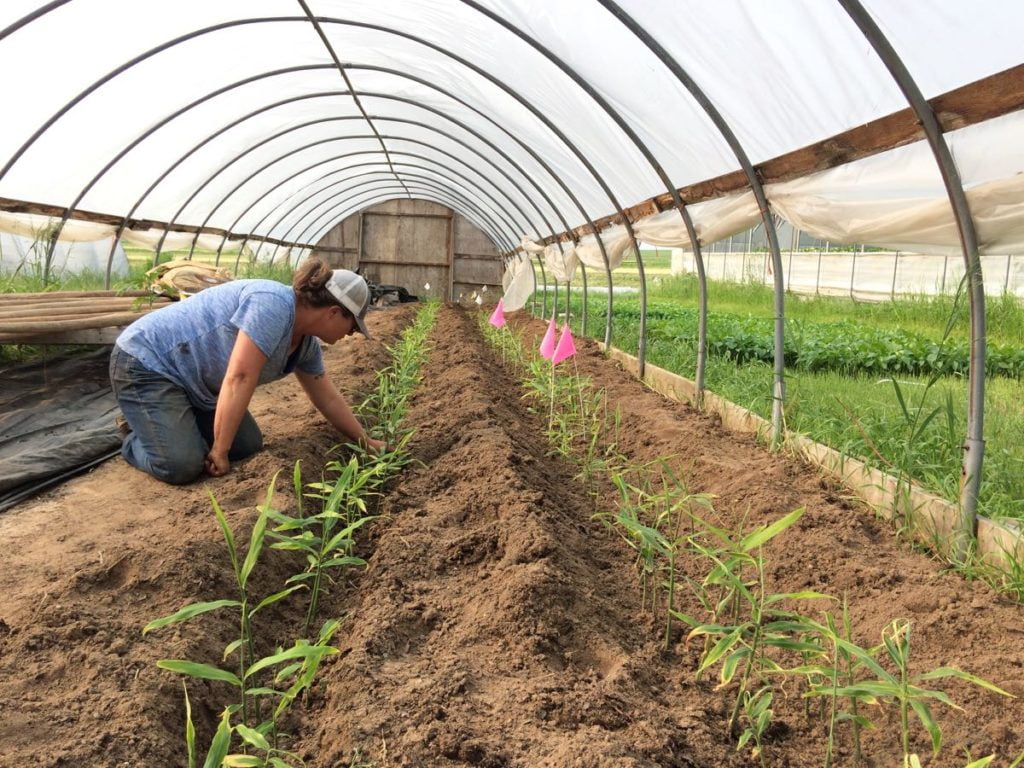
Kristen plants ginger on Friday.

Jory holds a beautiful cluster of baby ginger harvested during the outstanding 2015 season.
I nearly quit growing ginger. We’ve raised ginger for the CSA for 8 years. Yields have always been discouragingly low, except 2015 when growth was tremendous. That year, the ginger ‘seed’ we bought (cut pieces of gingerroot) arrived more sprouted than usual. We get the seed in March and keep it in a warm growth chamber for one to three months until it sprouts. I’ve tried to replicate early sprouting in subsequent years, without success. I love this crop and didn’t want to give up.
Instead of quitting, I contacted the nursery manager at our ginger seed supplier. I explained our low yields. Dan wrote back, “Hi Beth. The main reason the ginger sprouts faster has to do with the moisture content of the rhizome. It is facilitated by leaving it to dehydrate for a few weeks in a dry room. Dryer ginger sprouts faster.”
Who knew?? Everything I’ve read said nothing about this. I’ve always kept the seed carefully wrapped in towels so it wouldn’t dry out. We followed Dan’s advice and shortened the sprouting time by a full month. That gives the ginger an entire extra month to grow. That’s a big deal. I’m glad I made the small effort to learn more. This should be a good ginger year. We’ll find out this fall. Beth
Coddle Your Watermelons Seedlings
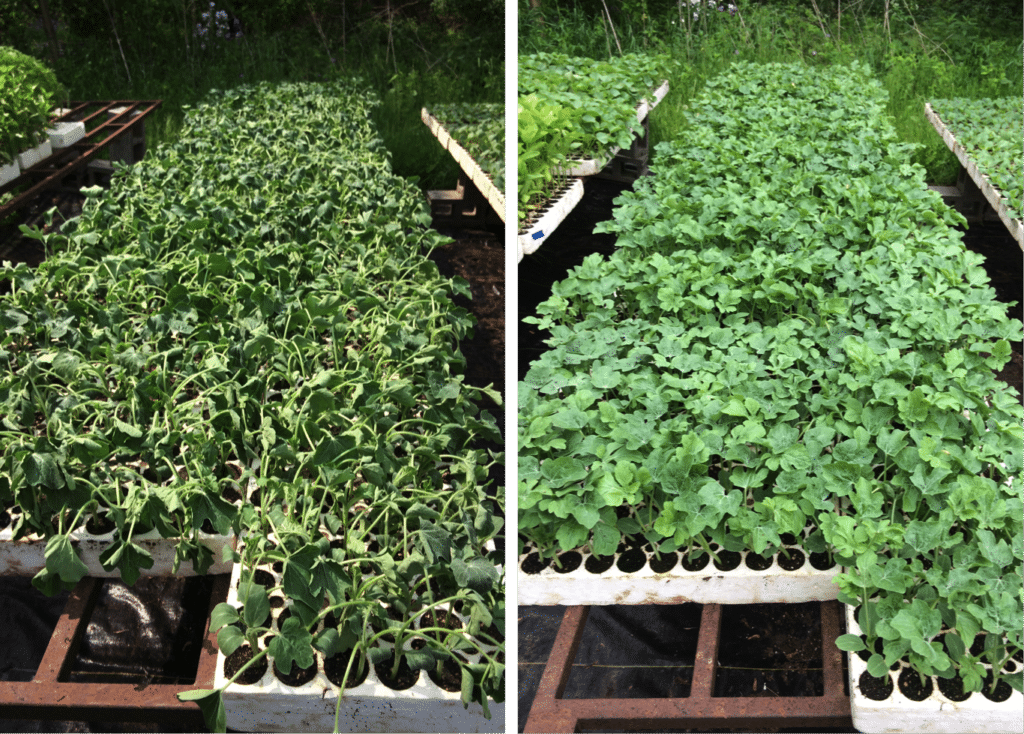
Left, watermelon seedlings, wilted after a cold night. Right, same seedlings, a few hours later.
Watermelon seedlings faint in cold weather. If their roots are cold and wet, the plants wilt dramatically. The roots stop taking up water but the tops continue to transpire. It can be fatal; the roots will die if left cold and wet. The seedlings look like they need watering but that’s the last thing you want to do. The solution is to warm the plants, and do not water until the root balls have warmed. We’ve learned over the years to be very cautious watering melon seedlings during chilly weather.
Farm News; Spinning Our Wheels
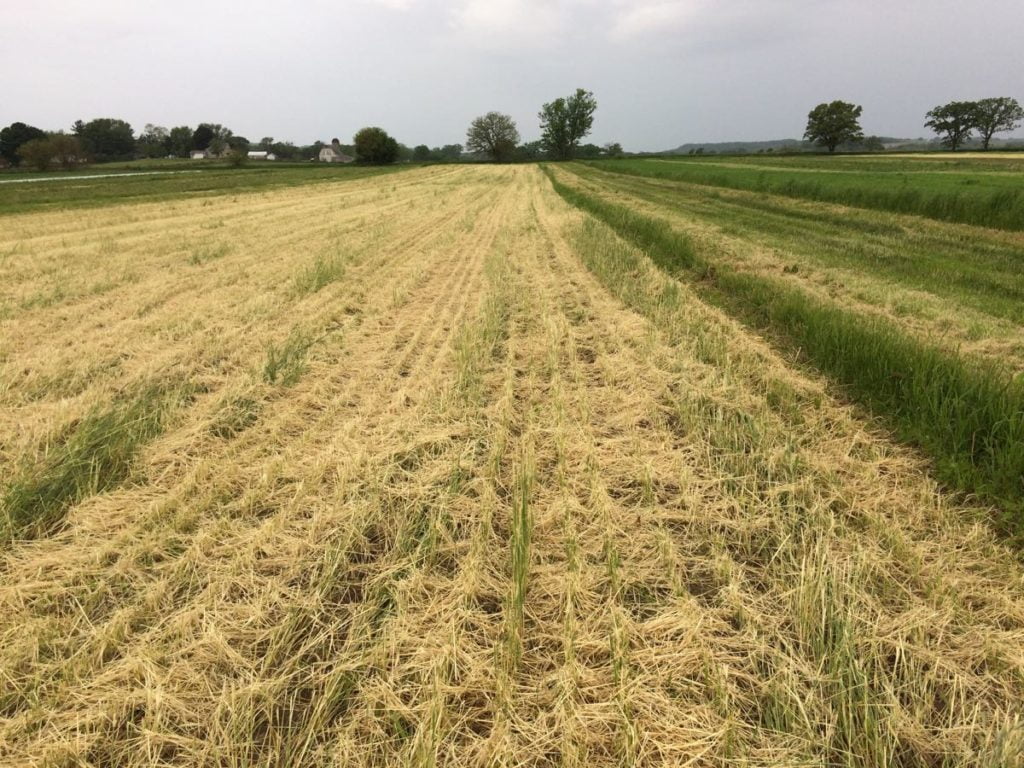
Chopped rye cover crop awaits tillage.
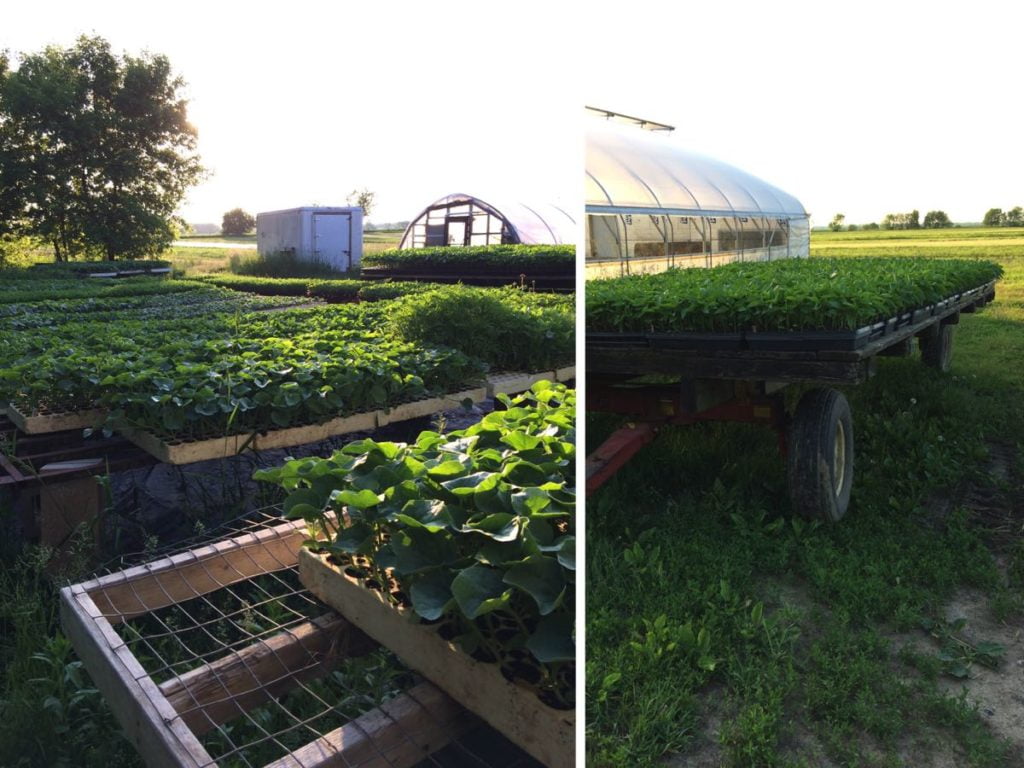
There’s a traffic jam at the greenhouses. All the outdoor benches (plus two wagons) are filled with plants ready to go in the ground.
The wet weather has slowed us down, and stopped all field operations except harvest. Our field tillage is stalled. We mowed down our rye cover crops but it’s too wet to work the residue into the soil. Steve is getting very impatient. We have many transplants ready to go in the ground. By this week last year, we had already transplanted all of our summer crops. Last spring was fast-moving with many warm days. Not this year. Unfortunately, there’s nothing we can do, except gather a crew to work on Saturday before it rains again on Sunday. We really need a break from the rain.
How to wash greens efficiently
Everything needs careful washing this week. All the rain splashed grit into the lettuce, escarole, etc. Here’s our approach. It works.
1. We have one kitchen sink so we use a 4 gallon Rubbermaid basin. Fill halfway with cold tap water. If you have two sinks, fill one sink partway with cold water.
2. Chop your lettuce, spinach, escarole or other green to the size you wish.
3. Dump it into the water and swish around gently but thoroughly.
4. Working in two batches (for average lettuce head) or more batches (big spinach bunches, Romaine), pull handfuls out of the water and drain in the basket of a salad spinner.
5. After all the greens have been rinsed one time, dump the water. Rinse the basin and refill with cold tap water.
6. Repeat the process.
7. Spin your greens dry and store in a dry container. They store much better when spun dry.
This works because …
– pre-chopping the greens frees soil trapped in the head.
– the large amount of water washes and dilutes away the grit.
– By pulling the greens out of the water, you take advantage of the draining action to pull the grit with it.
If you don’t have a salad spinner, try crew leader Kerry’s approach to dry her washed greens. She puts them in a colander, wraps the colander in a towel, and spins it around her head. This is a good job for outdoors. I hope this helps!
Veggie List and Veggie Notes
Week #3, June 6/7, 2019
– weekly shares
– every-other-week/ purple
– sampler/ sun
Asparagus, 2/3 lb
Shiitake mushrooms, 8 oz
Spinach, 1 bunch
Escarole, 1 large or 2 small
Romaine lettuce, 1 large or 2 small
White salad turnips, 1 bunch
Scallions, 1 bunch
Next week’s box will probably contain asparagus, greens, lettuce, white salad turnips, radishes, scallions & more.
Asparagus – Some of this week’s harvest is from our farm. Some is from our friends at LOTFOTL. All is certified organic.
Shiitake mushrooms – These are from Hidden Valley Mushrooms, the same people who grew last week’s button mushrooms. I love shiitakes cooked with spinach or other greens. Shiitakes must be cooked. A small subset of people can have a toxic reaction to raw or undercooked shiitakes. Once cooked, they are harmless. And tasty!
Storage: Refrigerate in a paper bag. These are perishable so use soon. Lightly sauce in butter and add to any dish. I will use mine in a frittata, as well as sauteed and mixed into pasta salad. Sauteed shiitakes and spinach are a great topping for rice bowls, e.g. bibimbap.
Escarole (broad head of wavy green leaves) – This member of the chicory family can be eaten raw or cooked. Its slightly bitter flavor is a good addition to mixed salads. It is excellent cooked alone or mixed with other greens. It cooks quickly, but not as quickly as spinach. Cover and refrigerate.
Romaine lettuce (upright head of lettuce with crisp leaves) – More sturdy and less fragile than our other spring lettuces. Great for Caesar Salad or lettuce wraps. Many heads have rusty spots at the base. However, what you see on the outside is the worst of it. Cut away the base just above those spots and you’ll eliminate the ones inside too.
White salad turnips (bunched white roots with green tops) – I know that returning members look forward to these sweet and delicious turnips, which taste nothing like the turnips that are harvested in fall. Don’t be fooled by how big the turnips are. These might be the best turnips we’ve ever grown.
– Storage: Cover and refrigerate.
– Uses: Both the turnip roots and tops are edible. The roots are excellent raw; Slice and add to salads. They can be cooked and are especially good when lightly sauteed in butter. Stir as little as possible so they brown on at least one side. The turnips greens are excellent cooked. Treat them like mustard greens.
– Our favorite use: Slice the roots very thinly and combine with a mixture of rice vinegar, mirin, soy sauce, sesame oil. Eat immediately or marinate.
Scallions (bundle of green onions) – These are useful raw or cooked. Thinly-sliced raw scallions can be folded into biscuit dough or sprinkled on top of soups or salads. Terrific garnish for pasta dishes. Think pad thai.
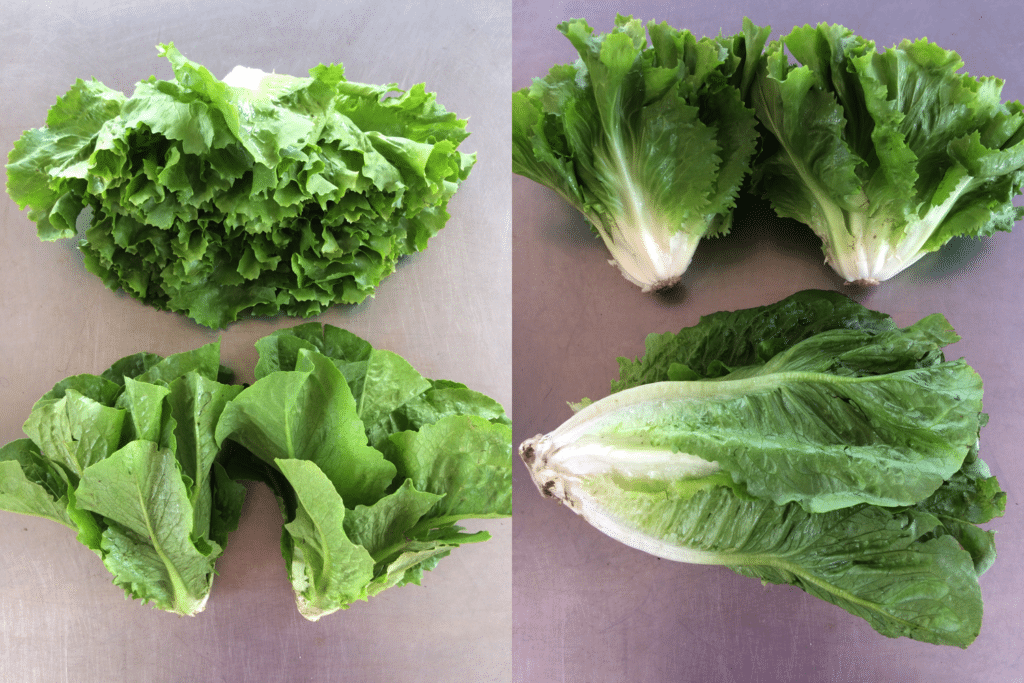
Escarole and Romaine lettuce look superficially similar. Escarole (top in both photos) has a broader fan shape and more bitter leaves. Romaine (bottom in both photos) is more upright and tastes like … Romaine. Most people get …
1 large escarole + 2 small Romaine OR
2 small escarole + 1 large Romaine.
RECIPES
Visit our 2019 Recipe Log or our 2018 Recipe Log or join our Facebook discussion group.
LOCAL THYME/ Comforting Classics
Cobb-ish Salad
Warm Escarole Salad
Scallion Pancake
Two Green, Salad Turnip and Feta Scramble
LOCAL THYME/ Outside the Box Recipes
Roasted Stuffed Romaine
Pan-Fried White Beans and Escarole
Grilled Salad Turnips and Asparagus with Scallions and Chili Garlic Sauce
Turnip Greens and Fish Tacos with Quick Pickled Salad Turnips
LOCAL THYME/ Quick & Easy Recipe
Spinach and Asparagus Pasta Salad with Feta
RECIPES FROM LAUREN
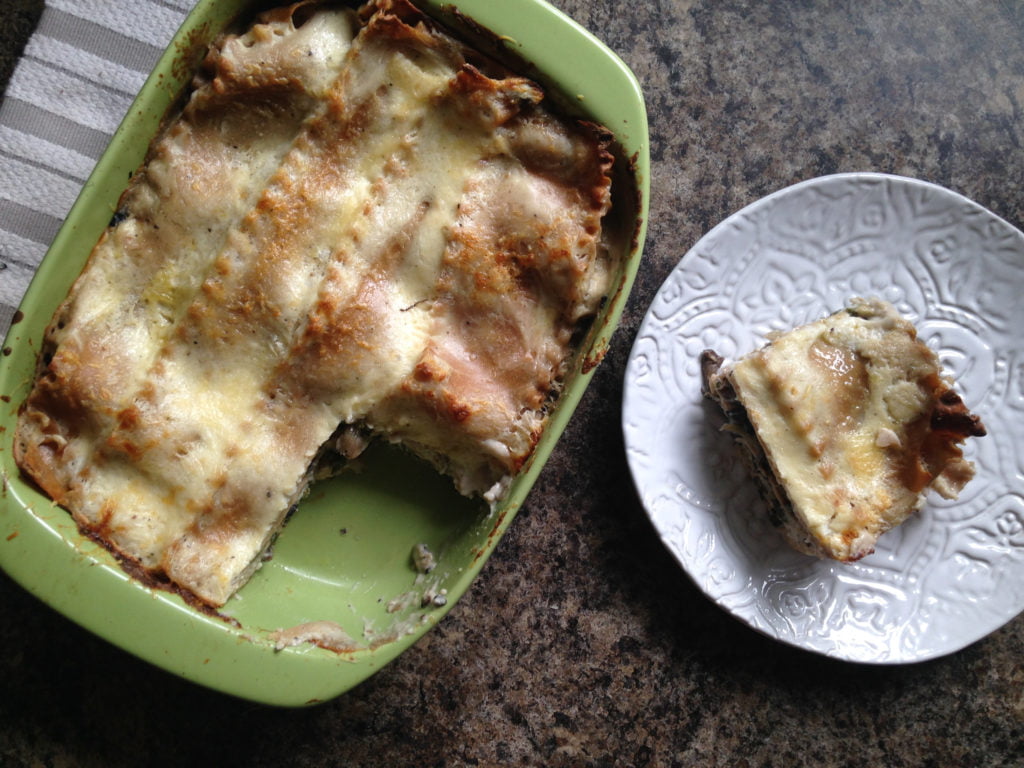
Photo credit Lauren Rudersdorf
SHIITAKE, ESCAROLE & SPINACH LASAGNA WITH WHITE SAUCE
Inspired by the great Ina Garten
Takes 1 hour, 30 minutes
Serves 6-8 depending on your appetite
10 tablespoons butter, divided
1/2 cup flour
4 cups warm whole milk (whole is preferred, but 2% will also work fine), I throw mine in the microwave for 60 seconds to warm it
1 tablespoon Kosher salt, divided
1/2 teaspoon freshly ground black pepper
1 pound dried lasagna noodles
3 garlic cloves, minced
3 scallions, white and pale green parts only, thinly sliced
8 ounces shittake mushrooms, cleaned and sliced
1 head escarole, roughly chopped (about 6 cups)*
1 head spinach (or turnip greens), roughly chopped (about 3 cups)*
1-1/2 cups freshly shredded Parmesan
- Preheat the oven to 375 degrees.
- Bring a large pot of salted water to a boil.
- While waiting for the water to boil, begin your white sauce. Melt 8 tablespoons of butter in a large saucepan over medium low heat. Once fully melted, add the flour and stir constantly with a whisk for 1 minute. Pour in the warm milk, 1 tablespoon Kosher salt, 1 teaspoon black pepper and whisk consistently for 15 minutes, scraping the bottom and edges of the pan occasionally, or until mixture is thickened. Remove from heat.
- By now, your water is likely boiling. Add the lasagna noodles and cook for 10 minutes or until al dente. Strain, toss with olive oil in colander and set aside.
- Meanwhile, melt remaining butter in a large saute pan (or even Dutch oven– you need a big pot to fit all these greens!) over medium heat. Add garlic and scallions. Saute for 3-5 minutes until fragrant. Add mushrooms and sprinkle with salt and pepper. Cook for about 3 minutes until just beginning to release their juices. Add the escarole and spinach and cook until greens are wilted, about 5 minutes longer. There will likely be a lot of liquid in the pan. That’s fine.
- In a 9×13-inch pan, begin to layer the lasagna. First spread about a 1/2 cup of white sauce on the bottom of the pan, just enough to cover it followed by three noodles, overlapped slightly. Add 1/4†of the remaining sauce followed by 1/3 of the mushroom mixture, and 1/4 cup of Parmesan. Continue this layering two more times: noodles, sauce, mushroom mixture and Parmesan. Finishing with a fourth layer of noodles, the remaining sauce and cheese.
- Bake the lasagna for 45 minutes, until the top is browned and bubbly. Let set for 15 minutes before diving in. Serve with a simple green salad.
.
*Much like the “Lots o’ Greens” quiche, this recipe really just needs 9 cups of any greens. I used escarole and spinach in my testing, but turnip greens, kale, radish greens, or anything else you have lying around (or want to use up first) would also work great!
.????
.????
BRIGHT SPRING SALAD WITH TURNIPS & APPLE
1 head lettuce, leaves washed, dried and separated, roughly chopped into bite-sized pieces
5 turnips, cut into match-sticks
1 sweet-tart apple (such as Pink Lady), cut into match-sticks
3 scallions, trimmed, thinly sliced
1/4 cup fresh lemon juice
1/2 cup olive oil
1 teaspoon finely grated peeled ginger
1 teaspoon poppy seeds
1/2 teaspoon Kosher salt
1/4 teaspoon freshly ground black pepper
1/2 cup chopped toasted walnuts
1/4 cup finely shredded Parmesan, optional
- Divide lettuce into four small bowls. Top with turnips, apples and scallions.
- In a large bowl, combine lemon juice, olive oil, ginger, poppy seeds, salt and pepper. Taste and adjust seasonings as desired.
- Drizzle a couple tablespoons of the dressing over each salad. Toss gently and add more to taste. Top with walnuts as well as shredded Parmesan if using.
.
Week #2, May 30/31, 2019
- On: May 29, 2019
 0
0
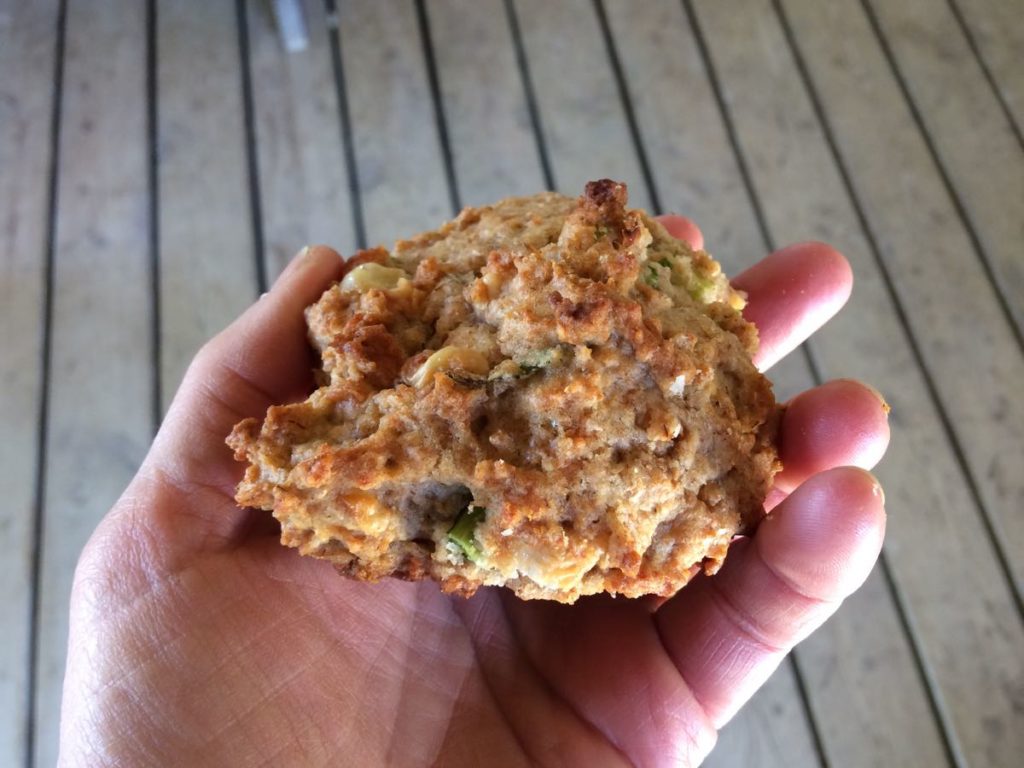
Biscuits with green garlic. Make your favorite biscuit recipe, but add lots of sliced scallions or green garlic.
Food as love
Our daughter Sophie came home from college for a week before starting a summer internship in Minneapolis. This is her first summer living away from home. Her visit fell during my busiest week, as we prepared for the first CSA delivery. My head was spinning with all the details. After watching us race around, she offered to cook dinner, a throwback to our ‘Wednesday night challenge.’ A few years ago, I challenged Sophie and Ari to cook dinner every Wednesday night. Actually, it was a command. On Wednesday, I am busy getting ready for the CSA pack and don’t have time for much else. The kids were young teens but they took this seriously, making lasagne and other sophisticated meals. Our kids know how to cook, and have been kitchen helpers since they were young.
For dinner, Sophie made us green garlic biscuits, turkey sausages and a huge mixed lettuce, spinach and arugula salad. I was thrilled for the help and pleased with her competence. During her school break this past winter, we sat down with my recipe folder and picked out favorites, choosing a list of 15 recipes she wants to learn. We accomplished a dozen before calling it quits. The fridge was stuffed with food and we were sick of cooking.
During the current visit, we added a few more favorites to her repertoire, including Penne with Spinach and Green Garlic. Tonight, this became the first meal she cooked at her new home in Minneapolis! The night before leaving, she regretted that we didn’t have time to make her favorite Rhubarb Pudding Cake so I got up early and baked one to send with her when she left. She wasn’t going to starve on the drive with a rhubarb cake in the car.
Food is central to our family life, so it’s not surprising that I mother my kids with food. I bet some of you do too. Beth
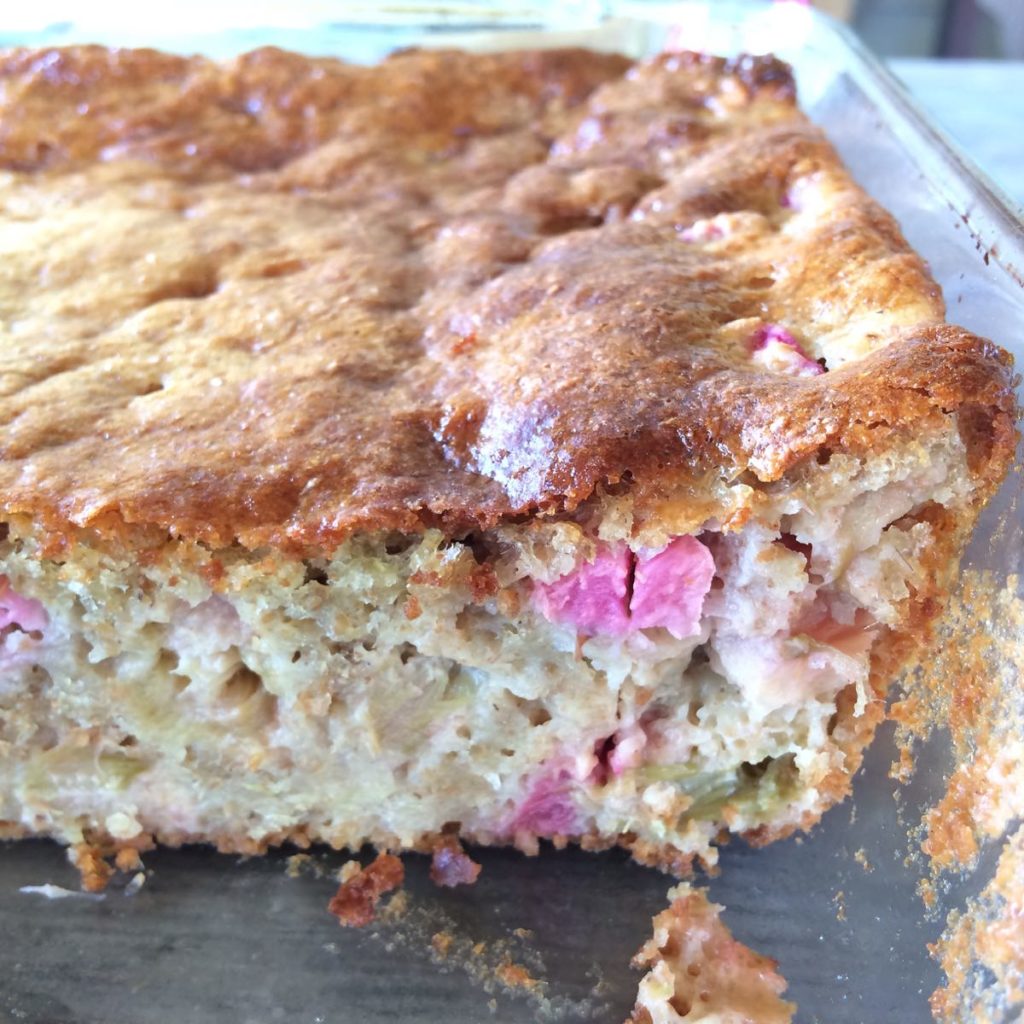
Rhubarb Custard Cake, so good warm from the oven. I’ll type up my recipe and post it in the Facebook page this week.
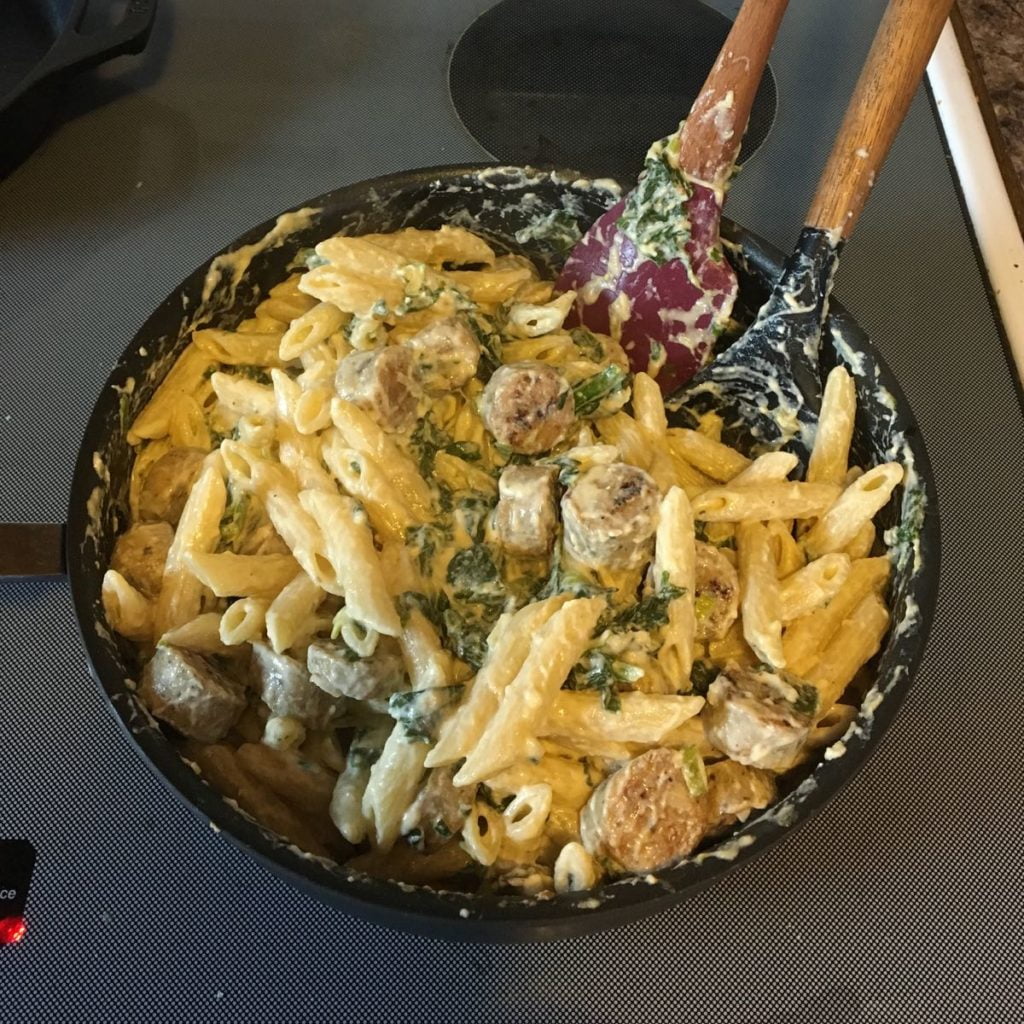
Sophie’s Penne with Spinach and Green Garlic, with chicken sausages mixed in.

Sophie and Beth (with Steve and Ari off-camera) at our favorite restaurant because it’s OK to eat out sometimes too.
Speaking of food love …
You folks have posted so many amazing dishes and recipes on our Facebook discussion page! I am in awe, but have been too busy to chime in. I counted at least 15 rhubarb recipes plus loads of vegetable dishes. It’s a closed Facebook group, just for our CSA membership. Go here to join. Take a look at last week’s posts; many will be useful with this week’s produce.
Veggie List & Veggie Notes
Week #2, 5/30/19
– Weekly shares
– Every-other-week/ green group
Asparagus, ~1 lb
Bok choy, 1 large
Spinach, 1 bunch
Button mushrooms, 12 oz
Red leaf lettuce
Arugula, 1 small bunch
Salad radishes, 1 bunch
Green garlic, 1 bunch
Rhubarb, 1.5 lb
Next week’s box will probably contain asparagus, spinach, escarole, shiitake mushrooms, white salad turnips, Romaine lettuce, scallions.
See last week’s newsletter for storage and cooking information for these vegetables:
Asparagus, spinach, lettuce, arugula, salad radishes, green garlic, rhubarb
Asparagus – This week’s asparagus is from our farm and from LOTFOTL Farm in Elkhorn, run by our friends Tim Huth and April Yuds. Tim is managing an organic asparagus field that’s larger than they need, and that they don’t have enough helpers to pick. Our asparagus is less productive this year because of Japanese beetle attacks last summer. We have the perfect joint solution; Steve, Karen and Kristin went down this week and harvested the asparagus, to deliver to you folks. This week’s delivery is about half our crop and half LOTFOTL.
Bok choy (large rosette with thick white stems and green leaves) – This Asian green is good for stir-frying or sautéing or in soup. You can think of the stems and leaves as two separate vegetables. The stems require longer cooking. The leaves will cook almost as quickly as spinach. Bok choy stores well, so feel free to pull off leaves as you need them, or use the whole head at once. Refrigerate in a plastic bag or other container.
Button mushrooms – These organic mushrooms are from Hidden Valley Mushrooms from Wisconsin Dells. We bring in mushrooms from Mary every spring, because I think they combine so perfectly with our spring vegetables, for salads, quiches, etc.
Storage: Here are Mary’s suggestions for storing the mushrooms:
– Store separate from leafy greens, which hasten mushroom aging.
– If storing for more than a few days, remove from the box and store in a paper bag with holes punched in the side. Keep dry.
– Don’t wash to clean, just wipe with a damp cloth.
Storage Tip – Rhubarb
Rhubarb is so easy to freeze for later use in muffins, cakes, stewed rhubarb, etc. Wash and dry your rhubarb stalks. Chop into the size pieces you want. Put in a freezer bag or container and place in the freezer.
That’s it! No blanching, no need to spread on a cookie sheet. The frozen chunks will stick together but are easy to break apart by slapping the bag of frozen rhubarb against your counter.
RECIPES
Visit our 2019 Recipe Log or our 2018 Recipe Log or join our Facebook discussion group.
LOCAL THYME/ Comforting Classics
Rhubarb Cream Scones
Asparagus Mimosa with Radishes, Capers, and Green Garlic Vinaigrette
Bok Choy and Tofu Fried Rice with Sesame Oil
Tortellini en Brodo
LOCAL THYME/ Outside the Box Recipes
Rhubarb Butter Glazed Bok Choy and Radish
Miso Roasted Asparagus
Coconut Curry Glass Noodle Soup with Bok Choy, Mushrooms, Radish and Chicken or Tofu
Roasted Trout, Radishes, and Asparagus on Wilted Spinach and Radish Greens
LOCAL THYME/ Quick & Easy Meal
Spinach, Arugula, and Radish Salad with Feta and Tuna or Chickpeas
RECIPES FROM LAUREN
MIDWEST BOK CHOY RAMEN SALAD
Takes 15 minutes.
Serves 2-4.
1 head bok choy, sliced thinly (stems and greens)
1 bunch radishes, greens removed, cut into matchsticks
2 green garlic, white and pale green parts, minced
1/2 cup roasted and salted cashews, roughly chopped
1/4 cup white or black sesame seeds (or a mixture)
Noodles from 1 package of beef ramen
Dressing:
5 tablespoons vegetable oil
1 tablespoons toasted sesame oil
2 tablespoons rice wine vinegar
2 tablespoons honey
Flavor packet from 1 package of beef ramen
Pinch Kosher salt
- In a large bowl, combine bok choy, radishes, green garlic, cashews, sesame seeds and ramen noodles. Toss to combine.
- In a small bowl, whisk together all dressing ingredients until smooth and uniform. Pour over bok choy mixture and stir well to evenly coat. Let sit 15 minutes before eating.
.
.
.
MUSHROOMS & “LOTS OF GREENS” SHEET PAN QUICHE
Inspired by Smitten Kitchen
Because this is a sheet pan quiche, it’s a little trickier to use store bought pie crust. I promise you that following the techniques below, you can make pie crust from scratch, but if you really don’t want to or don’t have the time, you could do this quiche in two store-bought frozen 9″ pie crusts. Trader Joe’s has really stellar frozen pie crust! You can also go crustless entirely and just make a delicious egg bake in a well-greased pan.
Takes 1 hour, 45 minutes if making the crust from scratch (much of it inactive) or 45 minutes with store-bought (or no) crust.
Serves 12-16.
Pie Crust:
1 cup butter (2 sticks)
1 cup water
2-1/2 cups all-purpose flour
1 tablespoon sugar
1 teaspoon salt
Filling:
2 tablespoons butter
2 green garlics, white and pale green parts only, minced
12 ounces button mushrooms, sliced
2-3 cups arugula, roughly chopped
2-3 cups spinach, roughly chopped
2-3 cups radish greens, roughly chopped
1/4 cup water
1 teaspoon Kosher salt
1/2 teaspoon freshly ground black pepper
1/4 teaspoon red pepper flakes
6 ounces cream cheese, softened
2/3 cups whole milk
6 large eggs
1 cup shredded cheddar cheese
1/2 cup finely grated parmesan
- Begin preparing your crust (if you plan to make it; if you don’t skip to step #8). Cut the butter into small cubes and place in the freezer until ready to use. Fill measuring cup with 1 cup cold water and place in the freezer.
- In a large bowl, combine flour, sugar and salt. If you have a food processor, combine flour, sugar and salt in there. This is my favorite way to make pie crust and it whips up in a snap!
- Add butter to bowl and use your fingers to incorporate the butter into the flour (or add it to the food processor and pulse until the butter is mostly broken up). You will pinch the butter cubes into smaller pieces until they are about the size of peas and uniformly incorporated. Some pieces of butter will be small and some will be larger; that’s absolutely fine!
- Remove†the water from the freezer and pour in half. Use a rubber spatula to press the dough together. If it’s still dry (it likely will be) continue to add water until the dough comes together. You may need to knead with your hands a little bit. (Here is where a food processor comes in great, turn the food processor on as you pour in about 3/4 cup of water and just leave it running until the dough begins to come together. It should take about 30 seconds, add a little more water if it seems to not be coming together).
- Wrap pie dough in plastic wrap and place in freezer for 20 minutes or in the fridge overnight.
- Remove dough from the freezer and roll out to an approximately 12×16-inch rectangle. Carefully, fold it in half and then in half again. Move the dough to a 10×14-inch baking sheet and unfold. Press gently into pan. Remove any excess dough from the edges. Prick the crust with a fork and place pan in the freezer.
- Preheat the oven to 425 degrees and while you wait for it to preheat, begin slicing your mushrooms and chopping your greens!
- Once the oven is preheated, line your pie crust with foil and fill with pie weights (or dried beans or rice you don’t plan to cook). Bake for 20 minutes. Remove the foil and weights and bake 5 minutes longer. If using store-bought crust, follow package directions for pre-baking.
- While the crust bakes, melt the butter for the filling in a large, deep saute pan (the larger the better, you’re going to be throwing a lot of greens in here– if you don’t have a large saute pan use a soup kettle) over medium low heat. Add the green garlic and cook for a couple minutes until fragrant. Add mushrooms and saute until soft, about 10 minutes more. Add all the greens, water, salt, pepper and red pepper flakes to your pan. Saute until the greens are well wilted.
- In a large bowl, beat softened cream cheese with a wooden spoon until smooth. Add the milk and whisk until smooth. Add the eggs, two at a time, again whisking until smooth after each addition. Stir in sauteed mushrooms and greens along with the cheeses.
- Pour filling into the prepared, prebaked crust and bake until filling is set, about 30 minutes.
.
Week #1. Let’s get started!
- On: May 22, 2019
 2
2
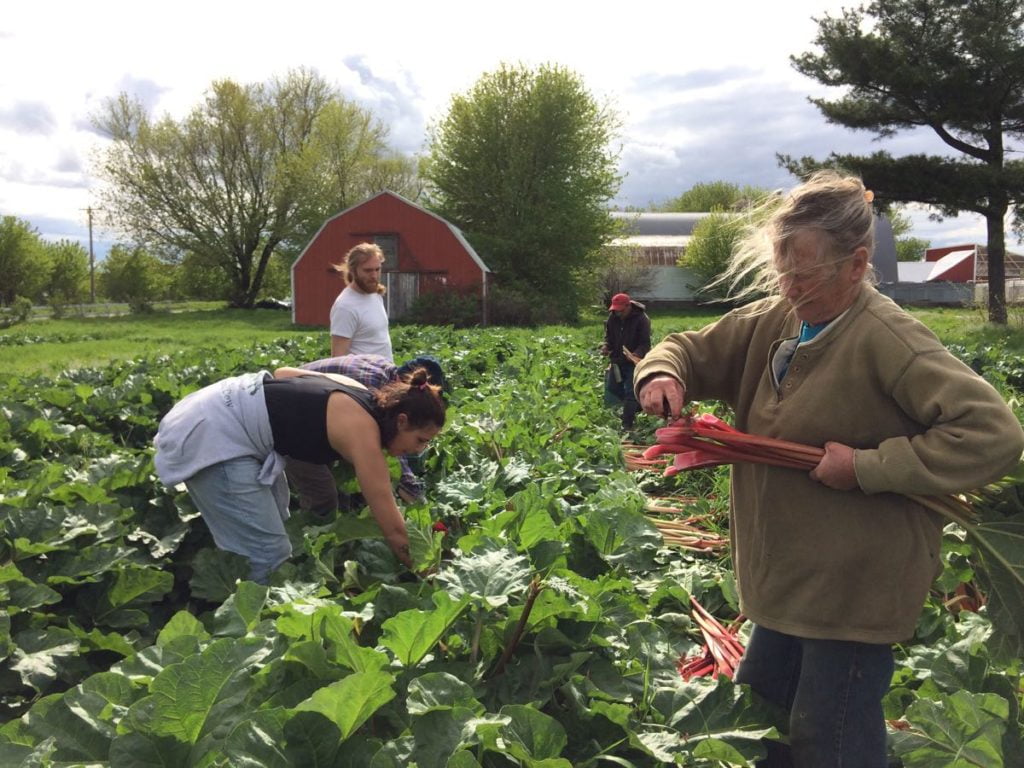
Simone leads a windswept rhubarb harvest, while she and Raul (back, right) train new employees. Our training program is simple. We pair new employees with experienced folks, and have them work side-by-side. There are so many details when you grow 40 crops and 400 varieties. We are fortunate to have enough returning employees to outnumber the new people 2:1. That eases bringing new people on board during the spring rush.
First Delivery!
Welcome to our CSA! Deliveries begin this week for:
– Weekly members,
– Every-other-week/ purple group
– Sampler/ moon group
Go here to check the delivery schedule for other shares.
Things you need to know.
♦ We post this newsletter/blog each Wednesday night, with a list of veggies for the week, quantities, information about storage and preparation, news of the farm, recipes, and a forecast for the next week’s box. We alert you by email on Wednesday night once the newsletter is posted and ready to read.
♦ Want earlier notice of what will be in the box? Check the sidebar on our website homepage around 7 p.m. on Wednesday night. I’ll post the list under “Box Contents.” I also provide a tentative list for the following week in the Veggie List section of this newsletter. The next week’s list is rarely complete but the items listed are ones we feel confident about.
♦ EOW, sampler and weekly members, we assume you read all the newsletters, even on your “off” weeks. This newsletter (and our emails to you) are our means to communicate with you.
♦ The first few boxes of the season are often the lightest. EOW members, do not worry that you have signed up for the wrong share! Our deliveries get heavier and more abundant as the season progresses.
♦ We will sometimes write “OR” in the produce list, e.g. green leaf OR red bibb lettuce. You will receive one of these crops. All the boxes at each site are identical; we pack the same crops for all the members at each site. Please don’t open other members’ boxes.
♦ Wash your produce well this week to remove grit. It has rained a lot lately, driving grit into the asparagus and anything that forms a head (lettuce, arugula, spinach). Our crew took extra care with washing but expect to wash everything. You should always wash your produce!
♦ On Thursday, we deliver CSA boxes to Evansville, Fitchburg, Madison, McFarland, Middleton, Oregon and Verona.
♦ On Friday, we deliver CSA boxes to Brookfield, Janesville, Mequon, Milwaukee, Waukesha and Wauwatosa.
Veggie List and Veggie Notes
May 23/24, 2019 (Th/Fri sites)
Asparagus, 0.6 lb
Spinach, 1 big bunch, ~1.5 lb
Green leaf lettuce, 1
Arugula, 1 bunch
Salad radishes, 1 big bunch
Green garlic, 1 bunch
‘Goldrush’ russet potatoes, ~3 1/2 lb
Rhubarb, ~2 lb
Next week’s box will probably contain asparagus, spinach, button mushrooms, lettuce, green garlic, bok choy, salad radishes, and rhubarb.
Asparagus – The asparagus is growing slowly because of the chilly weather, especially the cold nights.
Enjoy this spring treat! Your asparagus will be green or purple. The purple variety turns dark green when cooked. Its flavor is almost identical to normal green asparagus. Wash your asparagus thoroughly to remove hidden grit. Submerge in water with the tips pointing down, soak briefly, then swish vigorously and pull out of the water. The draining action helps pull the grit out of the asparagus tips. Repeat several times.
Storage: Asparagus is perishable, so eat it as soon as possible. Store in a paper towel, cloth or paper bag, then wrap loosely in a plastic bag. The paper bag protects the asparagus tips from direct contact with the plastic bag. The plastic bag keeps the asparagus from wilting.
Preparation: We snap our asparagus at harvest, rather than cutting. Therefore, there is no need to snap the stalks to remove fibrous ends. For the same reason, it is not necessary to peel the asparagus stalks. It’s OK to trim the cut end a bit.
Cooking: If your asparagus stalks vary greatly in size, you will want to cook the thicker ones longer. Put an empty steamer pot over water, and bring the water to a boil. Add the asparagus. Cover and steam over medium heat until just tender. Use two forks or a spatula to turn the asparagus during cooking, rotating the bottom spears to the top. Drain and serve. Alternatively, you can lay spears flat in the bottom of a broad pan, with ½ inch of water. Also excellent broiled or grilled. Good dressed with vinaigrette, or with lime juice, salt and pepper.
Lettuce and spinach – Wash your greens to remove grit splashed into the heads by rain. Cut to the size you like, submerge in water, swish gently, then pull from the water and drain in a colander. Some weeks, you will need to repeat in fresh water. I find it useful to use a kitchen tub for this job, so you don’t have to run an entire sink of water.
Storage hint – To extend the storage life of your tender greens, wash them, dry in a salad spinner, then store in a dry container or bag. Lettuce, spinach and arugula last much longer when handled this way.
Arugula – (bunch of green leaves with pungent scent) – This is a spring treat! Arugula is good mixed with lettuce or spinach in salads, or added to cooked dishes such as lasagne or quiche. I love it on sandwiches. This arugula is thin-leaved and tender and will not store for long. Eat soon. Cover and refrigerate.
Salad radishes – These are so good right now; tender, crisp and not too spicy. They are great in salads or thinly sliced on sandwiches. A few years ago, I was served open-faced radish and butter sandwiches on toast and was impressed with how tasty they were. Use good quality butter.
Storage: cover and refrigerate.
Green garlic (looks like scallions, tastes like garlic) – Last fall, we planted garlic cloves that grew into the stalks we harvested this week. If left to grow until mid-summer, the slim white bulb on this week’s garlic will divide and form the usual cluster of cloves in a garlic bulb. This year’s green garlic is robust.
Preparation: Green garlic is more pungent than scallions, so slice thinly and use sparingly when raw. It mellows when cooked. Chop and add to any cooked dish that would benefit from garlic. Use the white bulbs and pale green stems. Avoid the dark green stems and leaves, as these are fibrous.
‘Goldrush’ russet potatoes – Please refrigerate these potatoes. They are in great shape now but will sprout within days if stored at room temperature. They’ve been stored all winter and want to grow. Store in a paper bag to protect from light, even in the fridge. We grow everything we send in our CSA boxes except potatoes and mushrooms, both of which we buy from organic growers that we trust. We purchased these potatoes from Jesse Perkins at Vermont Valley Farm. ‘Goldrush’ are good all-around potatoes with outstanding flavor. With the predicted weather this weekend, you might want to make potato salad! Jesse says the potatoes have a higher sugar content because of starch to sugar conversion during cold storage. The potatoes taste a bit sweet, and will blacken slightly when fried. It’s a harmless color change due to the sugar conversion.
Rhubarb – Refrigerate in a plastic bag. FYI, 2 lb of rhubarb yields 6 – 6.5 cups when chopped.
Stewed rhubarb: This is the simplest way to prepare rhubarb. Chop rhubarb into one inch chunks. Stir over medium heat with a small amount of water in the bottom of the pan. The rhubarb will release moisture as it cooks. Stew until it softens and falls apart. Sweeten to taste with honey or sugar. Eat warm on its own, over vanilla ice cream, on pancakes, etc.
Recipes from chef Pat Mulvey at Local Thyme
Comforting Classics
Quinoa Salad with Spinach, Radishes, and Green Garlic Dressing
Turkey, Arugula and Cranberry (or rhubarb) Chutney Wraps
Rhubarb Sorbetto
How to make a great salad
Outside the Box Recipes
Velvety Lemon Pasta with Spinach
Green Garlic Arugula Pistachio Pesto
Caramelized Rhubarb
Spinach Salad with Rhubarb Vinaigrette
Quick and Easy Recipe
Hummus, Radish, Spinach and Arugula Pesto Wraps
Recipes from Lauren
SPRING NICOISE SALAD
Takes 45 minutes
Serves 4
4 eggs
1 pound russet potatoes, peeled and cut into rough 1-inch pieces
1 teaspoon Kosher salt plus more for seasoning
Lettuce, washed and cut into rough pieces
Arugula
1/2 pound asparagus, cut into 1-inch pieces, steamed
2 5.5-ounce cans Italian or Spanish tuna, packed in olive oil, drained and shredded
2-4 radishes, very thinly sliced
2 tablespoons capers
1/4 cup favorite olive, preferably kalamata or nicoise, optional
Freshly ground black pepper
Creamy Green Garlic Dressing:
3 green garlic, white and pale green part only, minced
1/4 cup white wine vinegar
2 tablespoons Dijon mustard
3/4 cup olive oil
- Bring a medium pot of water to a boil. Carefully lower eggs into water using a slotted spoon. Cook for 9 minutes. Remove to an ice bath for a couple minutes so they are easy to peel.
- Refill pot 1/2 full with water along with 1 teaspoon salt and bring to a boil. Add potatoes and boil for 10-15 minutes until potatoes are soft and easily pierced with a fork but not beginning to fall apart.
- While cooking, peel and slice hard-boiled eggs.
- Whisk together green garlic, vinegar and mustard together in a small bowl until smooth. Slowly drizzle in olive oil while whisking mixture until dressing becomes emulsified (thick and creamy).
- When ready to serve, combine lettuce and arugula into four bowls. Top with eggs, potatoes, steamed asparagus, tuna, radishes, capers, and olive oil. Drizzle with dressing and season with salt and freshly ground black pepper.
.
SPINACH, RADISH & GREEN GARLIC DIP
Adapted from Bon Appetit
Takes 30 minutes
Serves many
2 tablespoons butter
2 green garlic, white and pale green parts only, minced
1 bunch radishes, roots shredded and greens, roughly chopped
Spinach, roughly chopped
1 teaspoon Kosher salt
8-ounce cream cheese
2 ounces Parmesan cheese (about 1 cup)
1/2 teaspoon freshly ground black pepper
- Melt butter in a medium saucepan. Add garlic and saute for 1 minutes over medium heat until very fragrant. Add radishes and cook, tossing, until well-coated in butter, 1-2 minutes longer. Add spinach and radish greens along with salt. Cook until wilted and most of the liquid is cooked off., 5-10 minutes. Add cream cheese and cook until melted. Stir in Parmesan and pepper until melted and creamy. Taste and adjust seasonings.
- Serve warm with toast, in a bread bowl or with crackers.
.
Forward motion
- On: March 25, 2019
 2
2
Spring farm awards
We are making progress here. Let’s recognize our outstanding players.
AWARD: Best posture
AWARD: Cutest hats
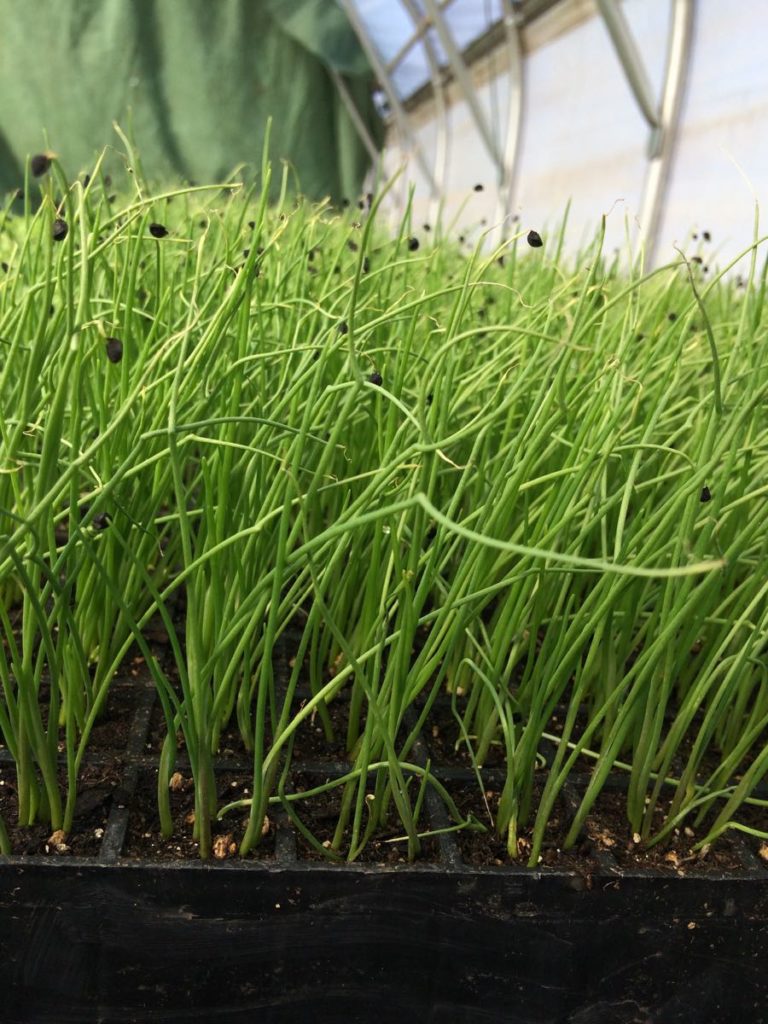
Scallions win two awards! Each ‘hat’ is a seed coat stuck to the tip of the plant’s first leaf. So stylish!
AWARD: Beauty Queen/King
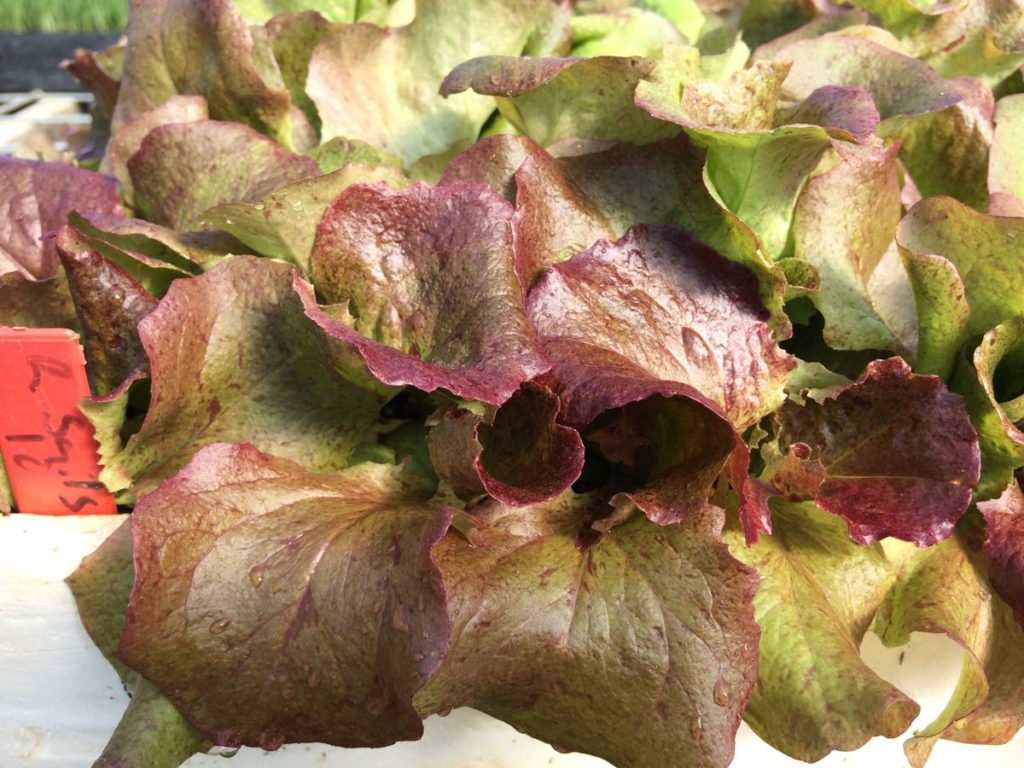
‘Red Sails’ lettuce wins the beauty contest every year for her gorgeous speckled leaves and green to red shading. We coddle these babies, nurture them in the field and … then we eat them. This lettuce will be in the first or second CSA box.
AWARD: Favorite place on the farm
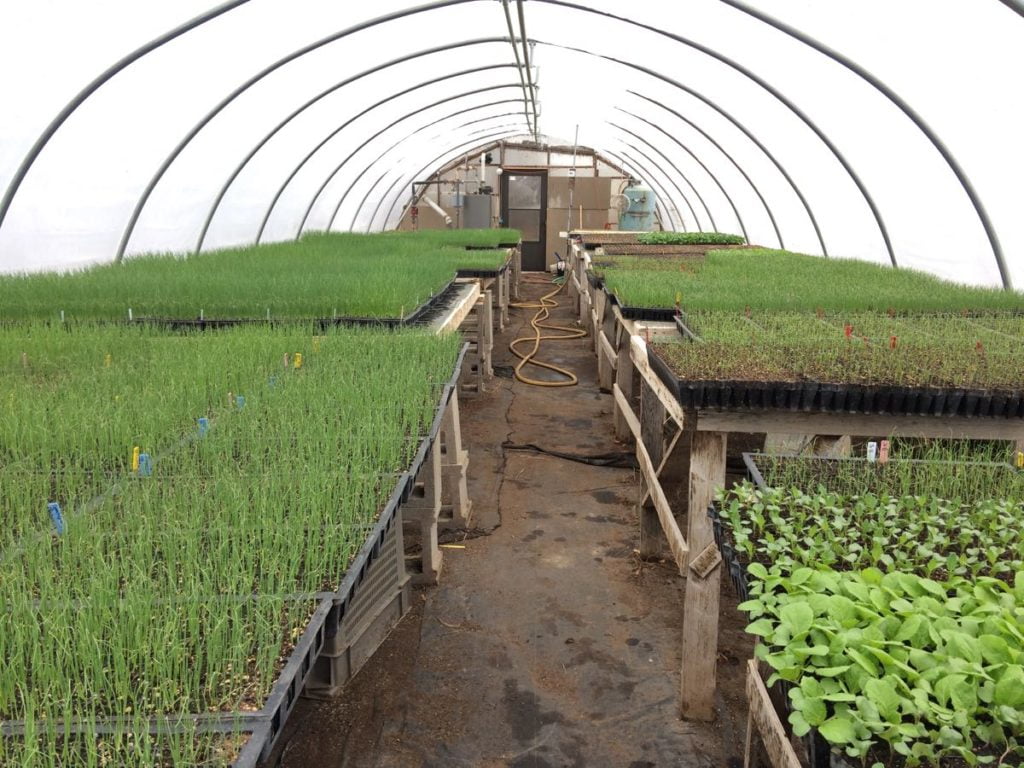
Hands down, it’s greenhouse #1. The thermostat is set to 74 degrees but the greenhouse warms to the mid-80’s on a sunny day. We’ve got two greenhouses in operation now. For a cooler place to eat lunch, greenhouse #2 is perfect, set to a pleasant mid-60’s.
AWARD: Most welcome
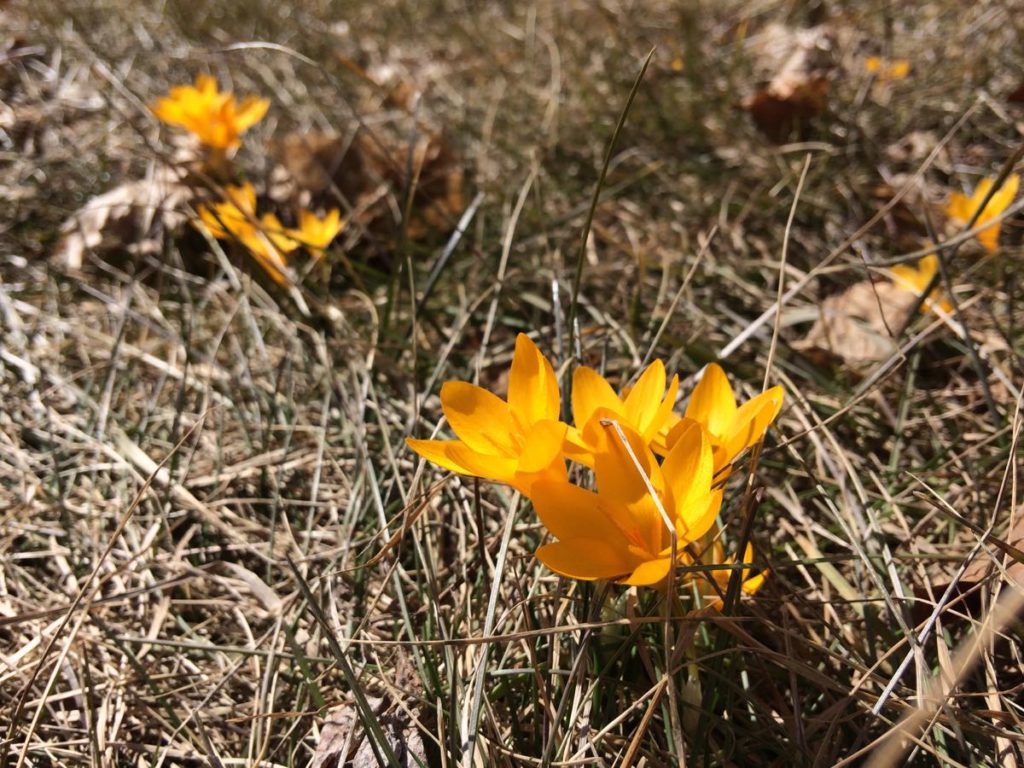
These tiny crocuses are the first flowers each spring. They’re in a sunny, warm spot in our yard.
AWARD: Most perseverant
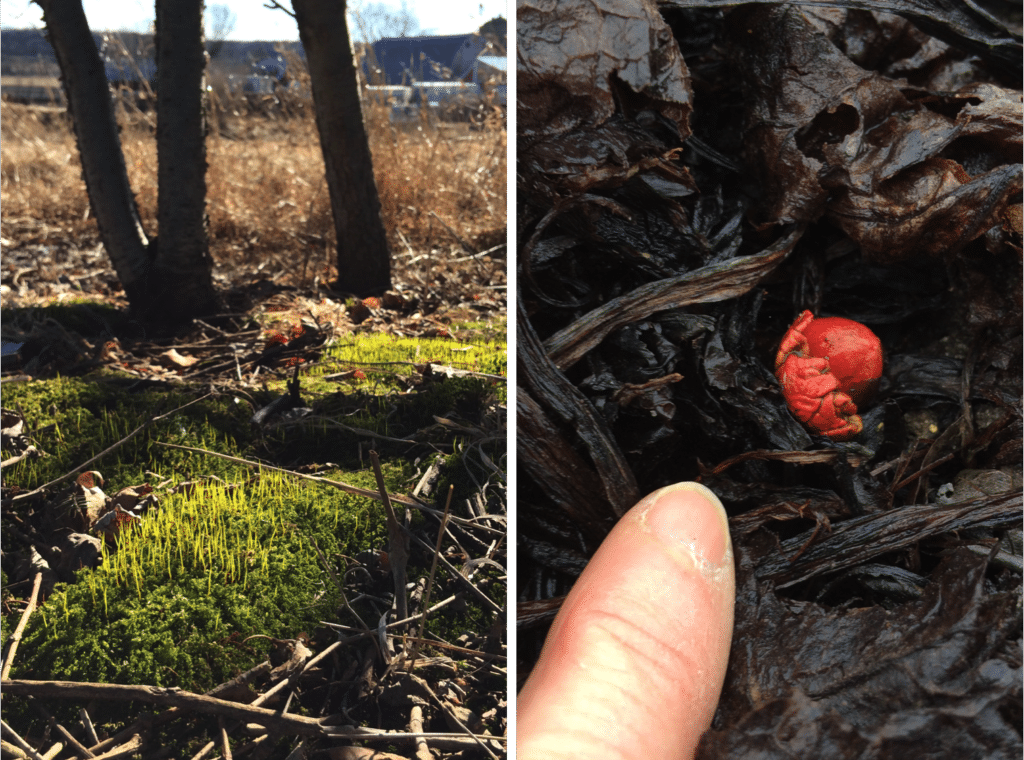
It’s a tie! Both these plants shrug off cold winters.
At left, even a little sunshine gets the moss growing.
At right, brilliant rhubarb buds emerge even when there’s snow on the ground.
AWARD: Most displaced holiday
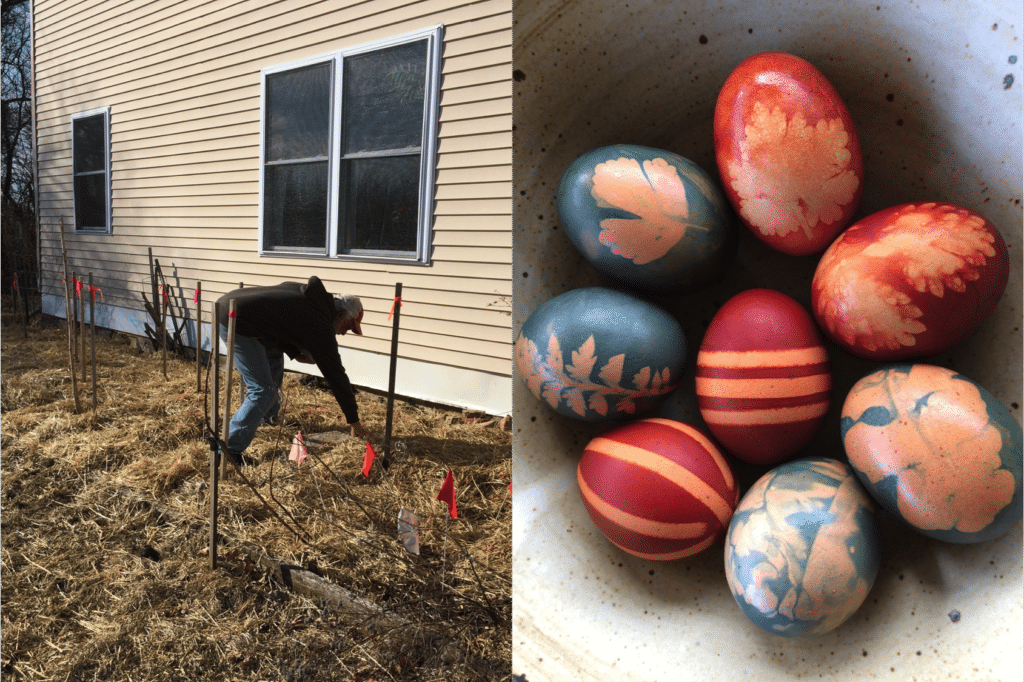
We celebrated Easter very early this year, while our daughter was home from college. Left, Steve hides eggs in my flower garden. The farm has many hiding places; egg hunts are epic in length. The eggs at right are dyed with red cabbage (blue eggs) or onion skins (brown eggs). Steve jokes that we should hide the afikoman matzoh, and celebrate Passover early too.
It’s time to sign up for your CSA share!
Our shares are selling quickly this year.
– New members, go here to enroll.
– If you were a Tipi CSA member in the past, enroll here.
Storage share, November 15/16, 2018
- On: November 14, 2018
 0
0
We are ready to wrap up this season. Then we’ll enjoy the winter, with lots of cooking, ice skating and skiing (we hope!) before beginning to plot next year. Have a wonderful Thanksgiving! Beth & Steve
Storage Share this week
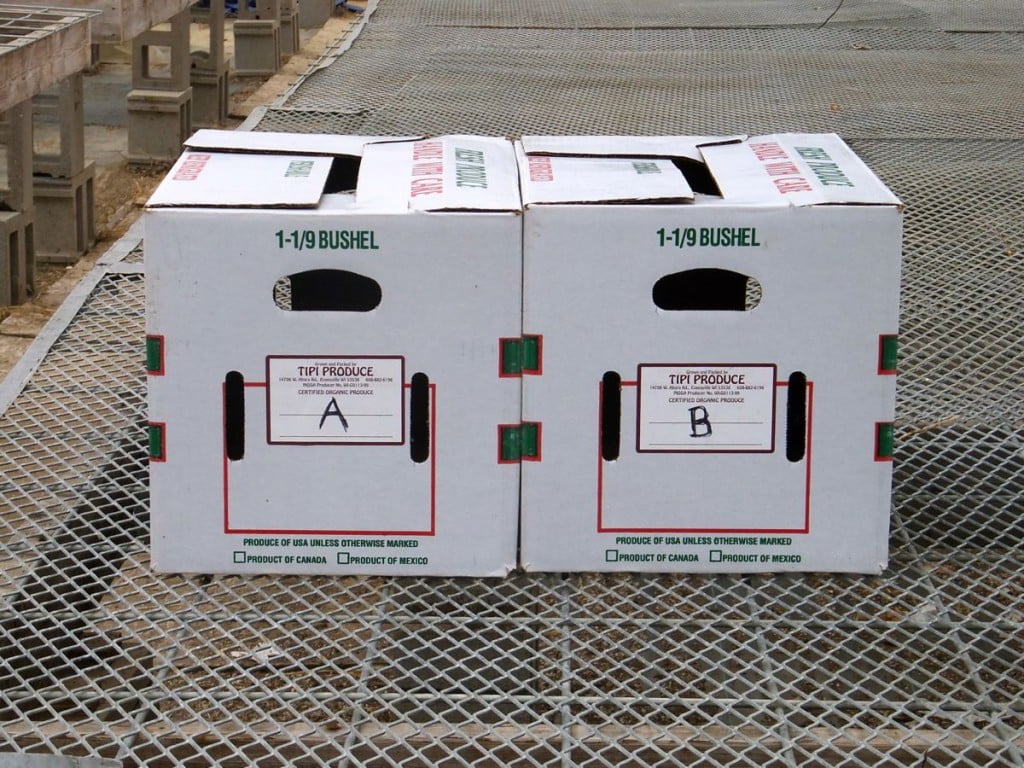
Take one box labelled “A” and one box labelled “B”.
Things you need to know about your winter share
* Your delivery will consist of two different boxes, labeled “A” and “B”. Take one “A” box and one “B” box. The boxes contain different vegetables.
* Please pick up your boxes on the day of delivery, during the normal hours for your site.
* Outpost members, pick up your boxes on Friday. This is the busiest weekend of the year for the Outpost staff, so they WILL NOT hold boxes past Friday, nor can they handle special requests.
* Members at unheated sites, please replace the blankets carefully. That keeps everyone’s produce in good shape.
* The boxes are heavy! Bring lots of bags to take your produce home.
Veggie List and Storage Info (Storage share, Nov. 15/16, 2018)
We hope you enjoy this shipment of veggies. Strategize to use them well, as some will last longer than others.
* These are the most perishable vegetables: kale, cauliflower, Romanesco.
* These are the next-most perishable: Brussels sprouts, cabbage, leeks, turnips and onions. Keep an eye on your butternut, potatoes and sweet potatoes. The last two are susceptible to drying out. Expect the largest butternuts to last the longest.
* These will last the longest: Beauty Heart radish, beets, carrots, celeriac, garlic, parsnips.
Box “A”
Refrigerate everything in this box.
Beauty Heart winter radishes, ~1.5 lb
Beets, 3 lb
Brussels sprouts, on stalk
Carrots, 6 lb total
….. orange ~4.6 lb
….. yellow ~1.5 lb
Celeriac, 1
Green cabbage, 1 medium
Kale
Leeks, ~1 lb
Parsnips, 2.5 lb
Turnips, a few
Mixed Romanesco and purple or green or white cauliflower, 3 – 4 lb total
Box “B”
The Brussels sprouts and onions need refrigeration. Everything else in this box can be stored cool or at room temperature. See notes below for more detail.
More Brussels sprouts stalks
Butternut squash, 6 – 7 lb
Garlic, 2 beautiful bulbs
Potatoes, Amarosa fingerlings, 2 lb
Potatoes, russet, 5 lb
Potatoes, Satina, 5 lb
Sweet potatoes, ~10 – 11 lb
Onions, 5 lb total
….. ~1.5 lb red
….. ~3.5 lb yellow
Beauty Heart radishes (round, white with pale green shoulders and bright pink interior) – Refrigerate. The interior color is lovely. Slice thinly and add to salads, cook lightly in mixed vegetable medleys or cut into matchsticks and add to pasta salads. We enjoy grated carrot and Beauty Heart salads all winter.
Beets – Refrigerate in a bag or container. Beets will store for two months or longer.
Brussels sprouts – Pluck from stalks and refrigerate in a bag or container. Do this the day you pick up your CSA boxes. Eat within 2 to 3 weeks.
Butternut winter squash – You will receive 6+ lbs of squash total. Store your butternut in a cool, dry place. 55 – 60 F is ideal. Do not put in a plastic bag. Expect the largest butternuts to store the longest. Inspect your squash frequently and cook promptly if you see any soft spots developing. You can cook, mash and freeze the squash for future use. I find that you can refrigerate cut raw squash for up to one week. This runs counter to the accepted way to store squash, but is useful if you want to cook just half a squash. Try microwaving your squash for one to two minutes before cutting or peeling. This softens the squash and makes a large butternut easier to handle.
Cabbage – Refrigerate.
Cauliflower (white, purple or green) – Refrigerate in a bag or container.
Carrots, orange. Refrigerate in a plastic bag. Will keep for several weeks.
Carrots, yellow. This variety is pretty AND they taste good.
Celeriac – Will store for months in your fridge. Cut off chunks as needed. Peel before using. I find it easiest to cut the celeriac into flat slices, then peel.
Garlic – Store at room temperature.
Kale – This mature kale is best cooked, rather than used in salads.
Leeks. Refrigerate and eat within three weeks. Leeks are not a long-storage crop. You may need to strip off one or two outer leaves to freshen the leeks before you cook them.
Onions: Refrigerate or store in a cool, dark spot and protect from light. Exposure to light stimulates sprouting. If you have the room, it’s safer to store the onions in the refrigerator. After the wet season, they might not last as long as usual.
Parsnips (These look like large white carrots.) – Refrigerate in a plastic bag. Parsnips will store for two months but will darken in color. That is a harmless change.
Potatoes, fingerlings, russets and Satinas – Can be stored at room temperature or in a cool spot, but must be kept in the dark so they do not turn green. A cloth or loose plastic bag draped over the paper bag will help avoid moisture loss, but do not close the plastic bag. All three types will store longer if kept cool. Around 40 – 50 F is ideal. The potatoes were grown by the Igl family near Antigo.
Amarosa fingerlings – This is a new addition to the Storage share for us. These fingerling potatoes have red skin, marbled red flesh and a creamy, velvety interior when cooked. They are delicious fried, baked, boiled, or steamed. Fingerlings really shine when simply roasted. Cut in half, oil well and roast at 400 F until soft. Don’t try to make mashed potatoes; they will turn gluey.
Russets– We got the big ‘baking’ grade so you have nice bakers for Thanksgiving. Excellent for baked or mashed potatoes.
Satinas– These are good all-purpose potatoes, everything from roasted to potato salad. I really like this variety of yellow potato because they oven-roast so well and because they are less sweet than other yellow varieties such as Yukon Golds.
Sweet potatoes – These are a mix of the Beauregard and Covington varieties. All types have developed excellent flavor and sweetness. Store at room temperature, no lower than 55 F, but 60+ F is better. Keep them on your kitchen counter where it’s easy to keep an eye on them. I like to keep ours in a paper bag so they don’t dehydrate. Cook promptly if they start to soften. The roots come in a wide ranges of sizes and all are good.
Turnips (white roots with purple shoulders and white interior) – Refrigerate. Scrub clean but do not peel. Excellent roasted, or mashed or scalloped with potatoes.
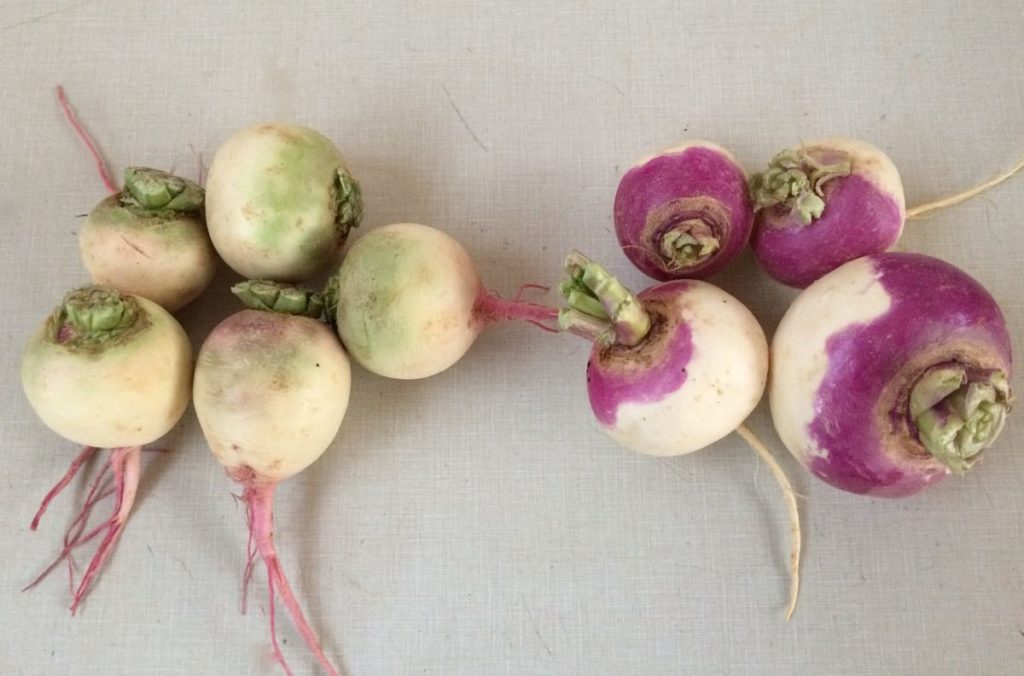
Beauty Heart winter radish (left) and turnips (right).
These roots look similar but are quite different. Beauty Hearts are winter radishes with a beautiful magenta interior. Their shoulders are green, white or blush pink. In contrast, turnips (right in photo), have purple shoulders and a white interior.
What are you cooking for Thanksgiving?
We are creatures of habit when it comes to Thanksgiving. Here are our plans so far:
– brined roast heritage turkey from our friends Jen and Bryce Riemer (Beth),
– Brussels sprouts with garlic-mustard vinaigrette (Steve),
– roasted sweet potatoes with garlicky yogurt sauce (Sophie),
– glazed butternut squash (Beth),
– crunchy carrot-Beauty Heart salad with sesame-seed dressing (Steve),
– some kind of slow roasted onion relish (Beth),
– homemade applesauce (Ari), and
– apple pie (Sophie).
I’ll probably make stuffing with lots of celeriac and onions but that might be overkill. Yeah, we tend to go overboard. We love celebrating Thanksgiving and the end of harvest season.
Menu Ideas
This is a great time of year to gather recipes to enjoy all winter. Online cooking sites post Thanksgiving menus and recipes, many suited to your Storage share vegetables. Peruse and bookmark the recipes soon; Thanksgiving collections are taken down quickly after the holiday.
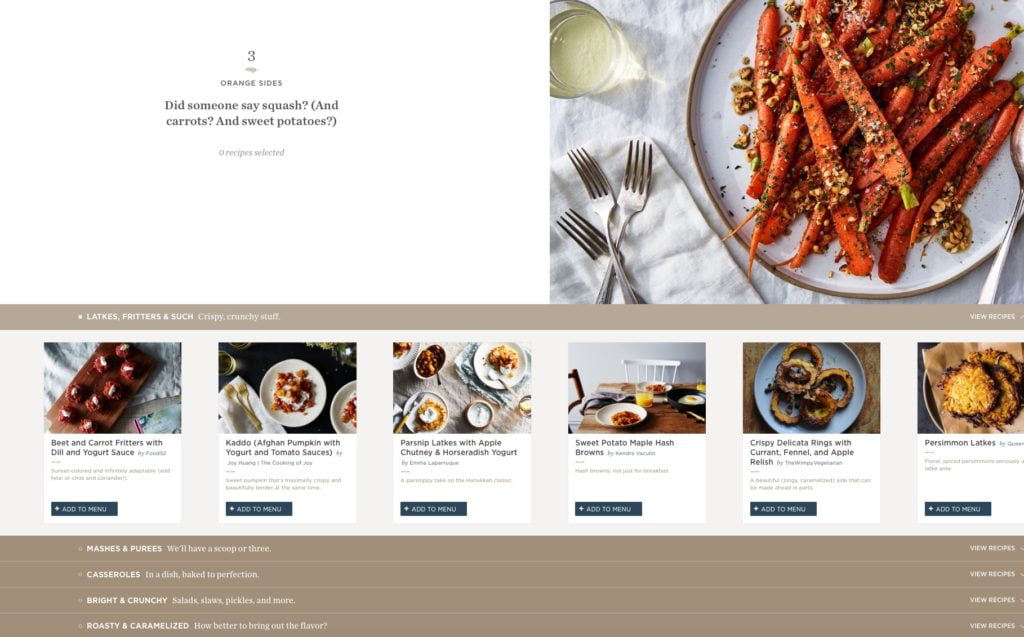
Food52’s Thanksgiving Menu Maker.
♦ IMHO, the lively Food52.com site has the best Thanksgiving recipe collection this year, possibly of all time. It’s titled AutoMagic Thanksgiving Menu Maker, and is beautifully organized by type of dish. Go straight to Section 3, “Orange Sides”, with multiple subheadings such as “Bright and Crunchy Salads” or “Roasty and Caramelized.” Move on to “Something Green” or “Gravies & More” or other tempting sections. I plan to gather a suite of recipes to try this winter.
♦ Smitten Kitchen is our go-to site for dessert recipes but has excellent veggie recipes too. Blogger Deb Perelman often posts her own plans for new Thanksgiving feast. This year, she has simply posted a collected list of Thanksgiving recipes from previous years. It is extensive!
♦ 101cookbooks. Always has good vegetarian and whole-grain recipes.
♦ The Dishing Up the Dirt site doesn’t have a specific Thanksgiving section, but many of her recipes are tailored to Storage share produce.
♦ Finally, remember that we can use Local Thyme recipes all winter. Check them out for Thanksgiving ideas.
Extension share, Nov. 8, 2018
- On: November 07, 2018
 0
0
Such a busy week
Temperatures are dropping sharply tonight, and tomorrow night, and every night for the next week. This brings a sudden end to our field season. We hustled all week to finish our field work. It has been a sprint.
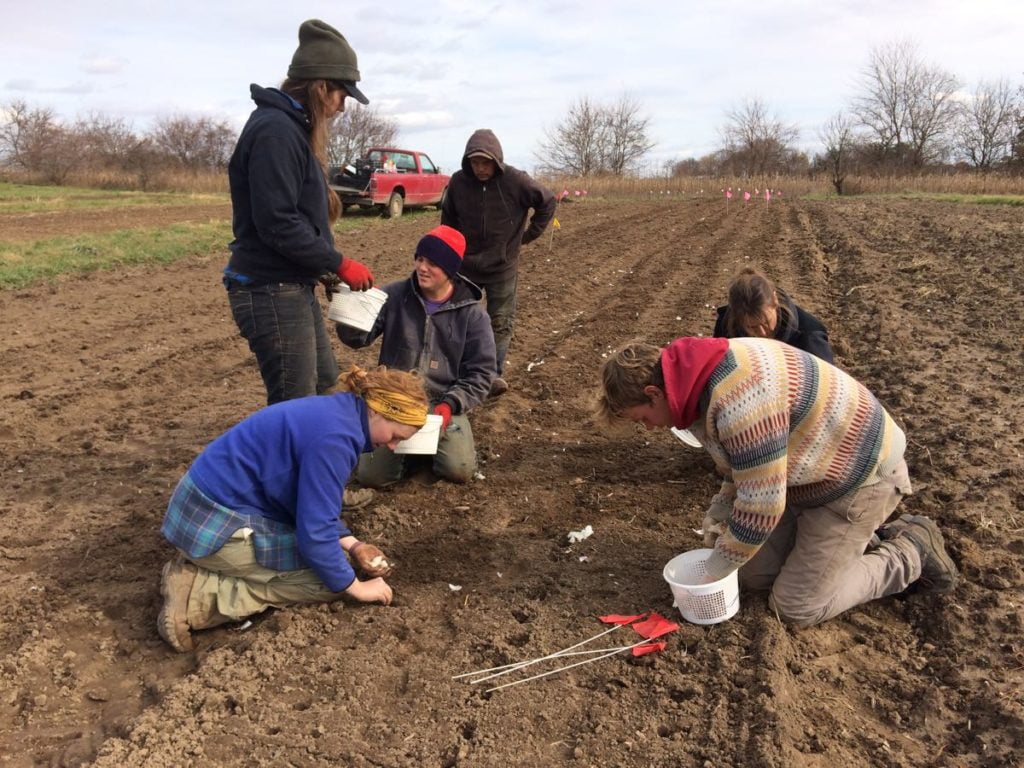
Garlic planting. We planted much more garlic than usual, with plans of having more garlic for the CSA boxes next year. First, I chose our best garlic bulbs. Then we cracked them into individual cloves. Each clove will grow into one bulb. We’ll mulch the field with straw soon, to protect the plants from fluctuating temperatures this winter.

Cabbage harvest. The heads are small this year, but almost all are perfect. This is good news. After the rainy summer and fall, we worried there would be rot in the cabbages but it has not been a problem at all. We also harvested all the remaining broccoli, cauliflower and Romanesco. We’ve been waiting for these cool-loving crops to size up, but they are out of time.

Rutabagas were our final root harvest for the year. Steve cleaned the harvester thoroughly this afternoon. Tomorrow, he’ll take it to the neighbor’s shed for the winter.

Even with a mechanical harvester, we still pick up dropped roots by hand. It’s worth our time.
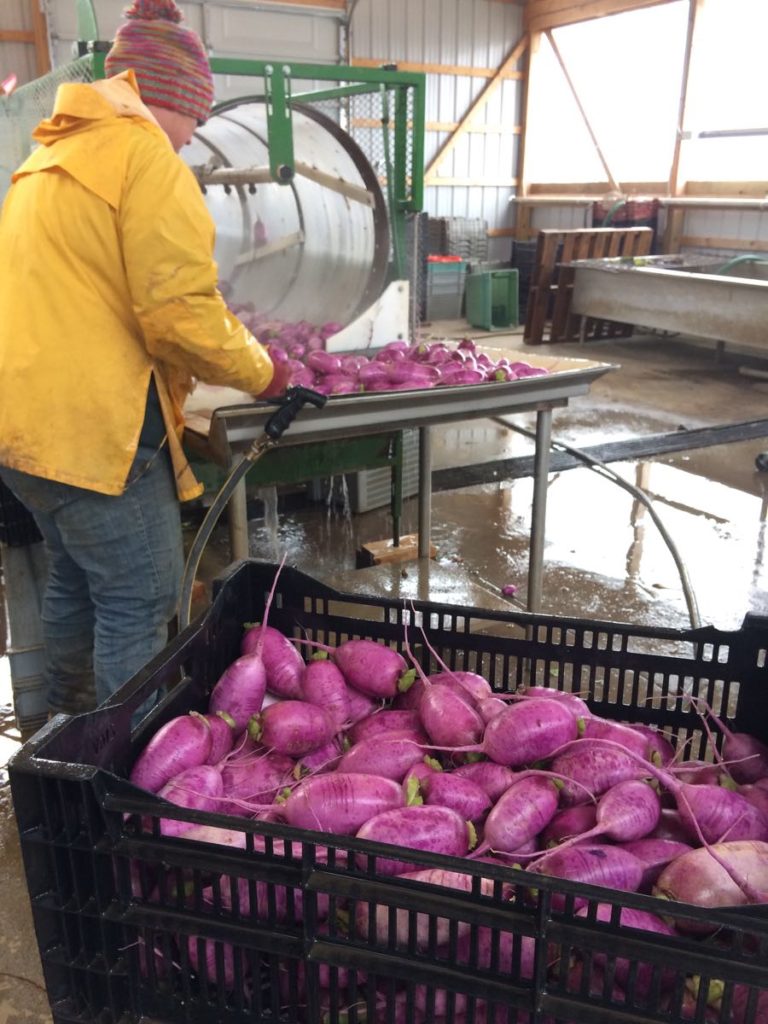
Maggie washes beautiful purple daikon for you.
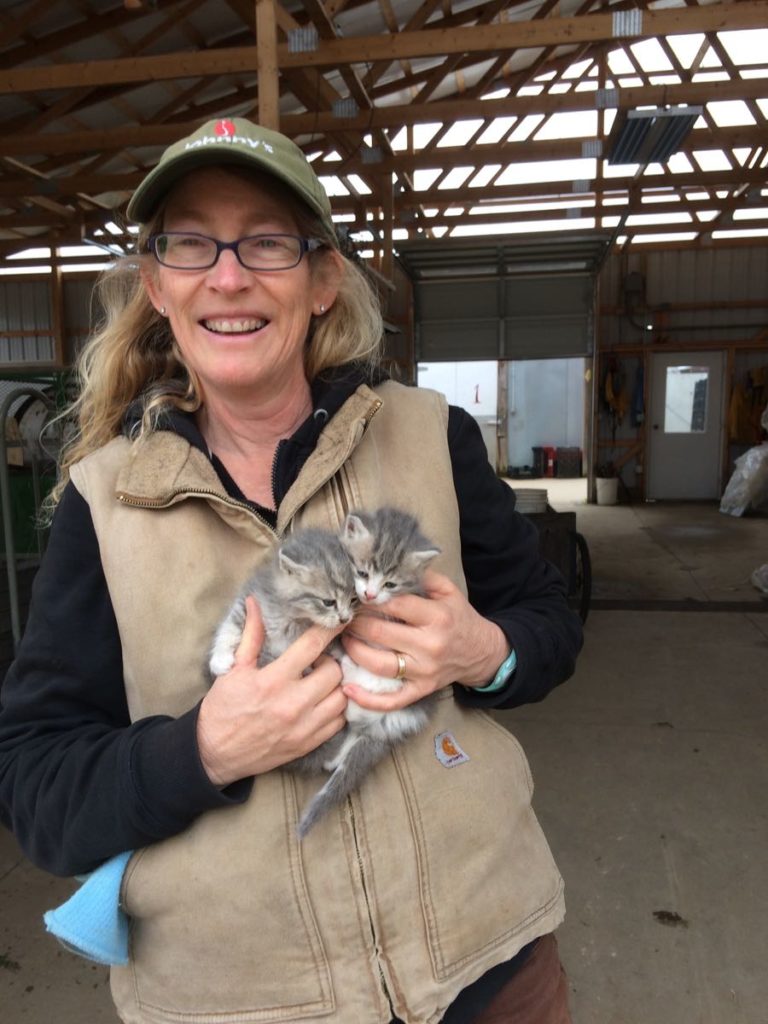
Our farm cat Charlotte abandoned her kittens on Monday, leaving me to bottle-feed them during a very busy week. I don’t look too dismayed, do I? Charlotte evaded capture when we got cats neutered earlier this year but we’ll try again. Both kittens are available for adoption.
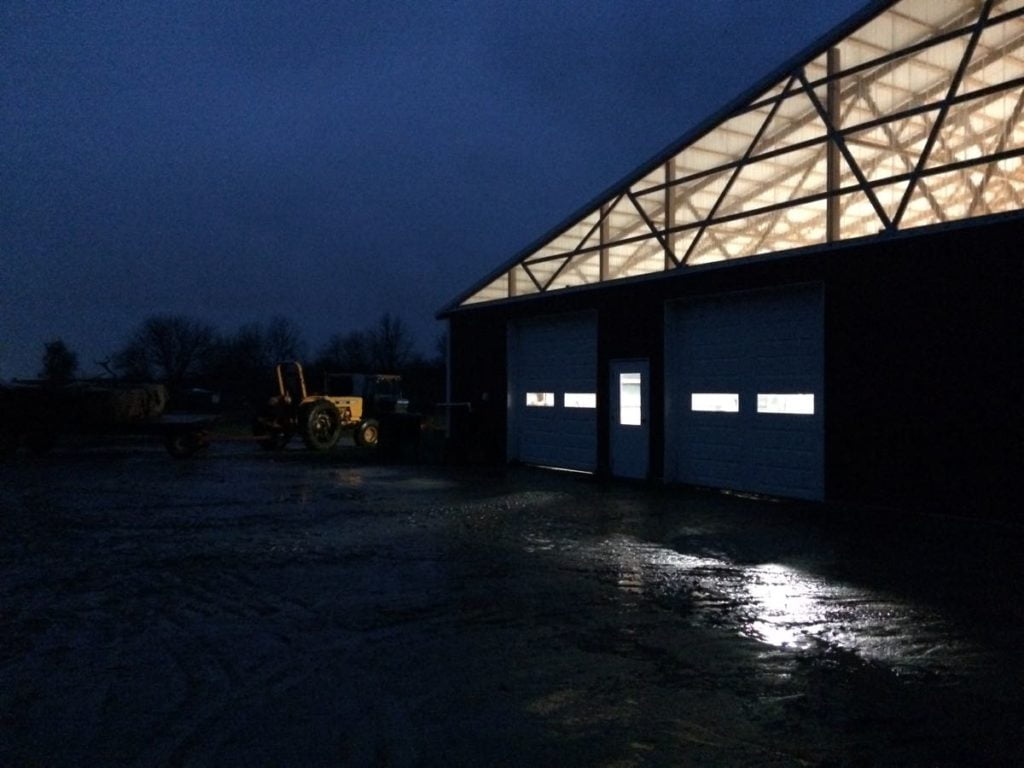
Daylight saving shortens our work days. We will finish a few harvests tomorrow, then our outdoor work in finished for the season! Beth
Veggie List and Veggie Notes
Extension Share, Nov 8/9, 2018
Sweet potatoes, ~2.5 lb
Butternut squash, 1 medium or 2 small
Portobello mushrooms, 2 – 3
Savoy cabbage, 1 medium
Carrots, 2 lb
Beets, 2 lb
Red mustard greens, 1 bunch
Purple daikon, a few
Broccoli OR cauliflower, about 1 lb total
Yellow onions, ~3
Portobello mushrooms – These beauties are from Mary at Hidden Valley Mushrooms in the Wisconsin Dells. We will pack them in brown paper bags. Mary says to store them in your fridge in the paper bag. Eat soon; they are fresh, lovely and perishable.
Purple daikon – These Korean radishes are so pretty. Slice or cut into matchsticks to add to cabbage or carrot salads.
RECIPES
Visit our 2018 Recipe Log or our 2017 Recipe Log or join our Facebook discussion group.
LOCAL THYME/ Comforting Classics
Moroccan Sweet Potato Soup
Braised Cabbage with Prosciutto
Chickpea Salad with Roasted Beet and Sunflower Seeds
Mustard Green Caesar with Chicken or Chickpeas
LOCAL THYME/ Outside the Box Recipes
Sunny Curried Sweet Potato Salad
Pasta with Cabbage and Meat Sauce
Beet and Cabbage Kraut
Mustard Greens and Turkey Salad
LOCAL THYME/ Quick & Easy Meal
Breakfast Bahn Mi Sandwich with Daikon and Carrot Pickles
LOCAL THYME/ Daikon recipes from July
Cabbage and Daikon Fried Rice
Curried Daikon
Fish and Cabbage Tacos with Quick Pickled Purple Daikon
RECIPES FROM LAUREN
BUTTERNUT SQUASH & BEET PIZZA
Adapted from Half Baked Harvest
I love love love the pizza dough recipe linked to below (by Pioneer Woman). It is my go to crust every single time I make pizza. I especially love it because it doesn’t only prefer to be made in advance, it actually gets better the longer you wait to use it. I am always making a batch on Sunday and waiting until Thursday or Friday to make a quick pizza. The way it slow ferments in the fridge makes a perfect crust every time (plus no kneading necessary!). If you don’t want to make a crust at least 24 hours in advance, than I recommend you use whatever recipe works for you quickly or getting a batch of store-bought dough instead. Lauren.
Serves 4-6
Takes 1 hour, 15 minutes
1/2 batch favorite pizza dough (see note above)
2 tablespoons olive oil
1 tablespoon maple syrup
1/2 teaspoon red pepper flakes
1/4 teaspoon cinnamon
3 cups cubed butternut squash
2 cups cubed beets
3 tablespoons butter, divided
2 yellow onions, thinly sliced
1 cup apple cider
1 tablespoon flour
1 cup warm whole milk
1/4 teaspoon Kosher salt
1/4 cup finely shredded Parmsean
1 apple, thinly sliced
1 ounce blue cheese
1 cup shredded Gouda cheese
- At least a day before you plan to make this pizza, make the pizza dough. Unless you have a quicker crust you prefer (see note above).
- Preheat the oven to 425 degrees.
- In a small bowl whisk together 2 tablespoons olive oil, maple syrup, cayenne, red pepper flakes and cinnamon.
- Spread the squash and beets out on a single layer and drizzle with olive oil mixture. Toss to coat. Roast in preheated oven for 25 minutes.
- Melt butter in a large skillet. Add onions, cook over medium heat for 10 minutes until softened. Add cider slowly (about 1/4 cup at a time) so that each addition soaks into the onions, caramelizing them slightly, before adding more. Cook onions until caramelized to your likely, about 20 minutes total.
- Meanwhile, prepare your sauce. Melt remaining butter in a small saucepan over medium heat. Add flour and whisk until incorporated. Let bubble and brown slightly for a minute. Reduce the heat to medium low and add the warm milk and salt. Stir consistently for the next 5-10 minutes until thickens into a thin sauce. Add Parmesan.
- Roll out dough into the size of your pan (round or rectangle will both work fine). Spread sauce over crust followed by half the roasted vegetables. Evenly distribute onions, apples and blue cheese over crust followed by the remaining roasted veggies and finally the shredded cheese.
- Bake for 30 minutes until crust is golden and crisp.
.
SWEET POTATO BIBIMBAP
Serves 4-6
Takes 1 hour
2 cups water
1 teaspoon Kosher salt, divided
1 cup brown rice
2 tablespoons white miso paste
2 tablespoons olive oil
4 cups cubed sweet potato
2 tablespoons butter
1/2 pound portabella mushrooms, sliced
3 cloves garlic, minced
1-inch ginger, peeled and minced
1 bunch mustard greens, ends trimmed and thinly sliced
2 tablespoons toasted sesame oil
2 tablespoons sesame seeds
1 daikon, cut into matchsticks
1-2 carrots, cut into matchsticks
Soft-boiled or fried eggs, optional
Sauce:
2 tablespoons tamari
1-2 tablespoons sriracha
1 tablespoon sugar
1 tablespoon water
1 tablespoon rice wine vinegar
1 tablespoon toasted sesame oil
- Preheat oven to 425 degrees.
- In a medium saucepan, bring water and 1/2 teaspoon salt to a boil over high heat. Once boiling, add the rice. Reduce to a simmer, cover, and cook for 45-50 minutes until rice has absorbed water.
- On a baking sheet, combine sweet potatoes, olive oil and white miso as best you can. There will likely be some small chunks of miso in places. Don’t worry about that too much. Roast in preheated oven for 25 minutes until browned.
- In a large heavy skillet, melt butter over medium heat. Add mushrooms and remaining 1/2 teaspoon Kosher salt. Saute for 10 minutes until softened but still maintaining some bite. Remove to a small bowl.
- Add garlic and ginger to the same pan you cooked the mushroom in. No need to wipe it out (you don’t want to lose any of those delicious mushroom juices). Saute for 2 minutes over medium low heat until fragrant. Add mustard greens. Wilt over medium heat for 2-3 minutes. Add toasted sesame oil and saute 3 minutes longer. Finish with sesame seeds and continue cooking until greens are as wilted as you like.
- In a small bowl, whisk together sauce ingredients. Use 1 tablespoon sriracha if you aren’t a big fan of spice. Use the full 2 tablespoons if like a bit of heat.
- Serve cooked rice with sweet potatoes, mushrooms, greens, raw radish, raw carrot, a drizzle or two of sauce, and a cooked egg if you please.
.
Final regular season delivery
- On: October 31, 2018
 0
0
Goodbye from the Tipi crew!
We took the photo in August, hence the shorts, mud boots and sandals. We’re a big group when we are all together, and this isn’t everyone.
Front row from left; Smitty, Mari, Simone, Kerry. Back row; Michio, Ellen, Sena, Taylor, Karen, Maggie, Kristin, Raul, Beth, Steve, Billy (in back) and Jose. MIA; Jory, Charlotte, Josh, Ben, Jon and high school students Ari, Chance, Tyler, Kevin and Shane.
Let’s review the season.
Folks, this was a poor season for us. If we did our jobs well, you might not have noticed. You are always our first commitment, so the CSA boxes were full and varied, but our wholesale trucks went out half empty. Why? Too much rain, for too long. This isn’t news; we all experienced the wet weather this summer. We couldn’t weed effectively. Crops grew slowly and poorly. All our planting schedules went out the window. Even our winter storage crops are coming up short, although the carrot crop looks OK. Whew. We’ll know more as we continue to harvest carrots and cabbage over the next few weeks.
What were the bright spots?
– Everything in the squash family was spectacular this year. Melons, cucumbers, winter squash were all abundant and good quality. We loved being able to share so many melons.
– Most of the rain fell at night! This allowed us at least a few rain-free hours each day. This is hugely important when you work outside. As Steve says, “most days we could stay dry above the knees.”
– We did not need to irrigate!
– Our resilient, professional crew was the season’s shining light. They stayed in good spirits despite the mud and rain. They bring so much energy to this farm. Let’s give them a round of applause.
We look forward to wrapping up our carrot and cabbage harvests, then enjoying a slower pace this winter. Have a great winter.
Beth and Steve
Extension and Storage Shares
Some of you have registered for these shares. You know who you are. We’ll be in touch as we get closer to delivery.
A few photos from the week
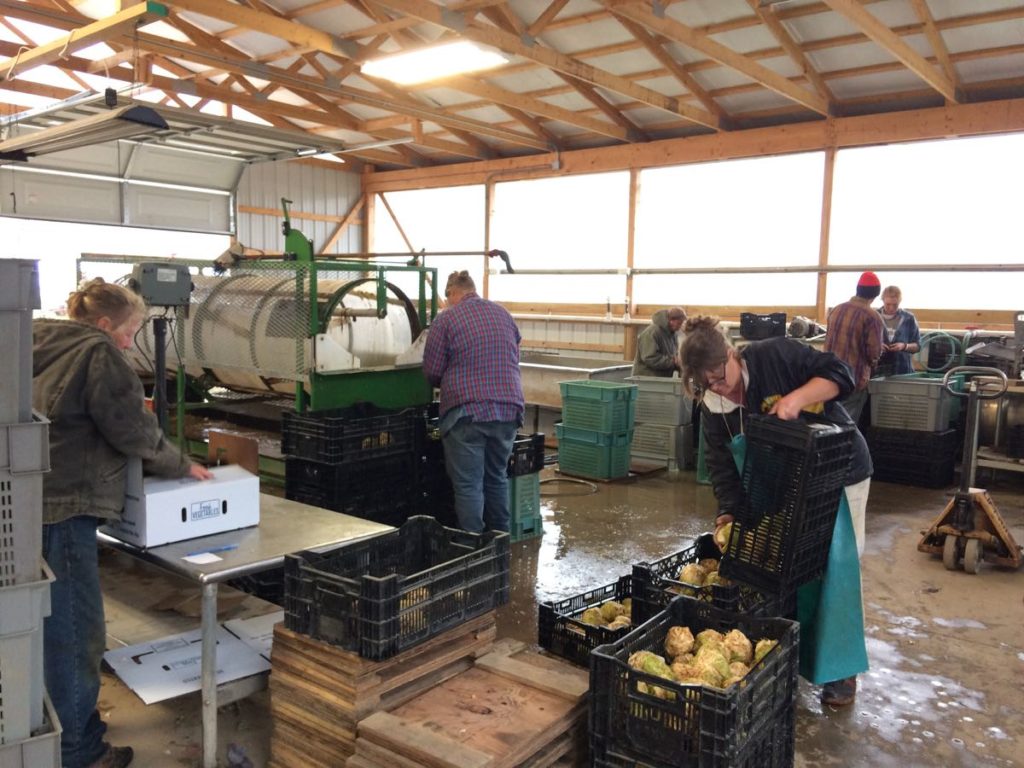
A busy moment in our summer pack shed. It’s been almost two years since we built this light-filled shed. It’s a great place to work but we appreciate it most in fall, when we can close the doors and protect ourselves from the wind. From the front, Simone folds boxes, Maggie and Kristin wash celeriac. In the back, Raul, Jory and Mari wash poblano peppers.
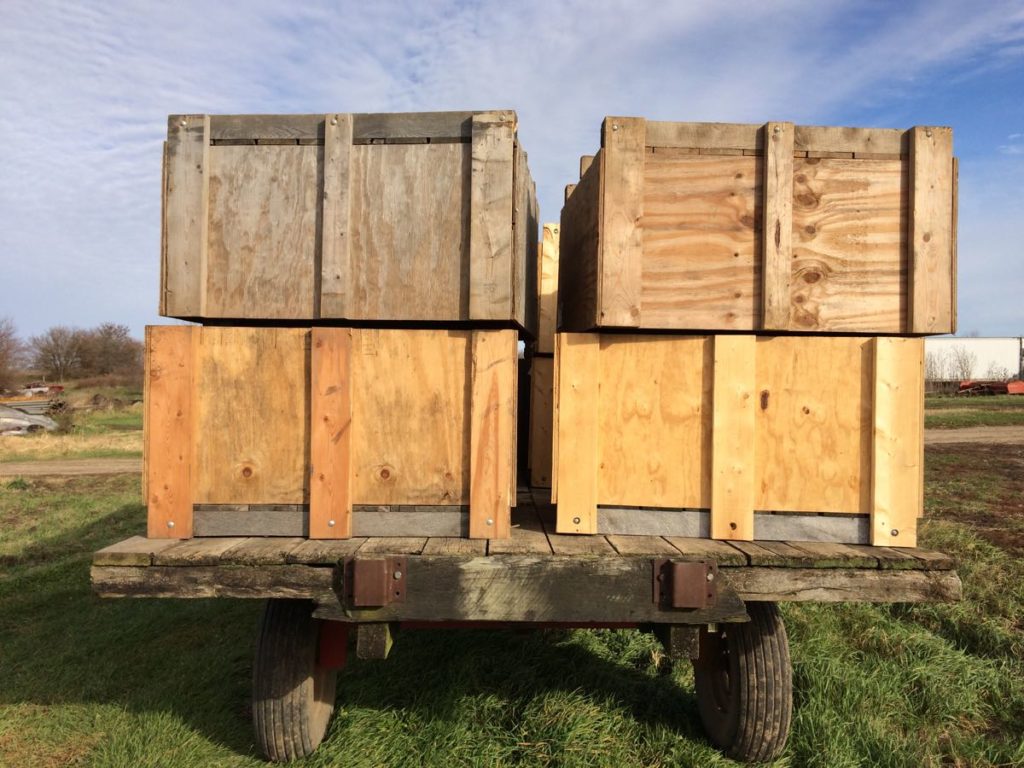
A load of storage bins ready to go the field. We’ll keep harvesting carrots for the next two weeks.
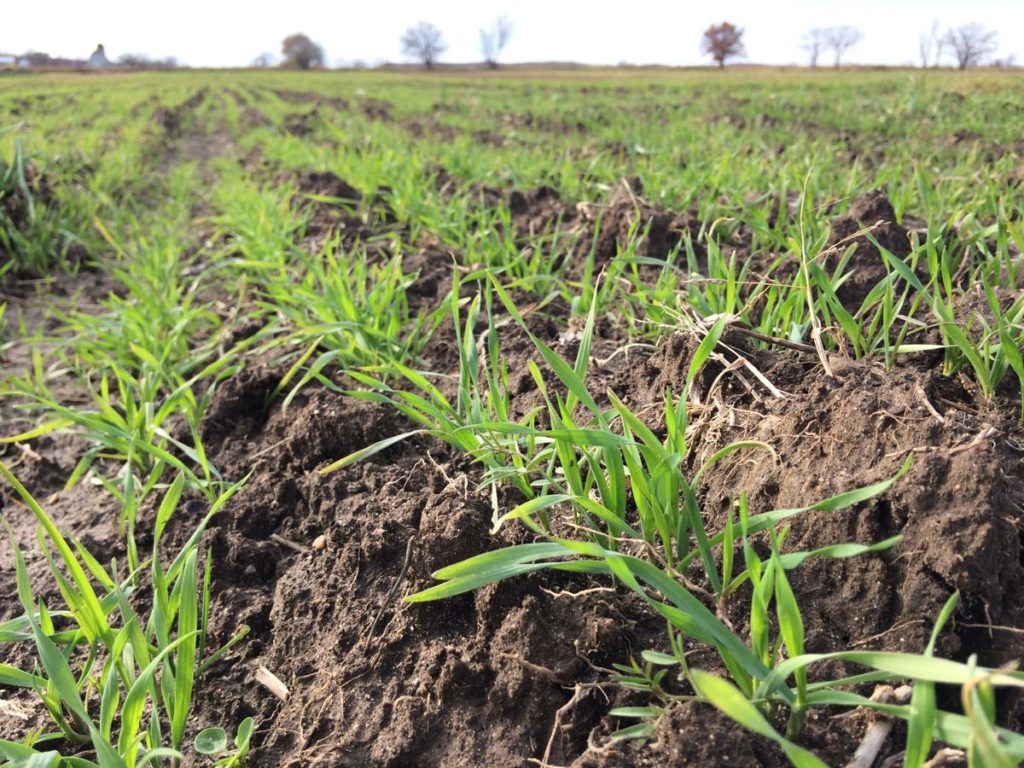
The cover crops are growing slowly. You can see how rough the ground is. The field was wet when Steve seeded the rye and vetch, leaving big ruts in the soil. It made the job difficult but doesn’t matter in the long run. By the time we’re done chopping and tilling this cover crop in June, the surface will be level again.
Veggie List and Veggie Notes
Week #24, November 1/2, 2018
– weekly shares (final box!)
– purple EOW (final box!)
– moon sampler (final box!)
Sweet potatoes, ~2.5 lb
Leeks, 1/2 lb
Brussels sprouts, ~0.8 lb
Parsnips, 1.1 lb
Celeriac, 1 or 2
Carrots, 2 lb
Fennel, 1 bulb with fronds
Red mizuna, 1 small bunch
Poblano chiles, 3 or 4
Flat parsley, 1 medium bunch
Garlic, 1 small
Sweet potatoes – This is a mix of Beauregard and Orleans varieties. We’ve grown Beauregard for many years. Orleans is a new variety for us this year and we like it very much. It’s as tasty as Beauregard but makes nicer clusters of roots.
Parsnips (tapered, cream colored roots. In bag with carrots) – Those long, white roots are not carrots, they are parsnips. The two vegetables are related. When cooked, parsnips are sweet and starchy. For the best flavor, brown them to caramelize the sugars. Here are a few ideas for parsnip preparation:
– Caramelize the parsnips by roasting them in a vegetable medley.
– Parsnip fries are delicious: cut like French fries, coat very lightly with oil, place on a cookie sheet and roast in a hot oven until brown and cooked through.
– Try substituting grated parsnips in a potato pancake recipe. They brown beautifully and are very tasty.
– Steve loves pan-fried parsnips with onions and garlic.
Celeriac (knobby, round, bizarre-looking vegetable which smells like celery) – Flavorful celeriac is good raw or cooked. It is excellent in mixed roasted veggies or in soup. It’s especially good in cream soups, alone or mixed with potatoes. Grated raw celeriac is a great starting point for winter salads. Celeriac will store in your refrigerator for months. Cut off chunks as you need them. Peel before using.
Fennel (large vegetable with a fat bulb and lacy fronds) – Fennel is a ‘swing vegetable’; it can be used raw or cooked. Clean well and slice as thinly as possible for use in raw salads. It is good simply prepared with olive oil, lime or lemon juice, salt and shaved parmesan cheese. Cooking softens and sweetens fennel, and mellows its anise flavor. Both the bulb and leaves are edible. Here are ideas from Alice Water of Chez Panisse about how to use fennel: ‘It’s strong anise characteristic seems to suit fish particularly well. … We use fennel all the time. We add the feathery leaves to marinades for fish and to numerous salads, sauces and soups and we use them as a garnish, too. … The bulbs are sliced and served raw in salads in various combinations with other vegetables, parboiled for pastas; caramelized and served as a side dish; braised whole; or cooked in vegetable broths & fish stocks.”
Red mizuna (red, frilly bundle of greens) – Mizuna is a type of mustard greens. Can be eaten raw or cooked.
Poblano chiles (dark green, shiny, triangular) – EAT SOON. We protected these plants with row cover outside for as long as we could. They’ve been exposed to cold nights which shortens their storage life. Eat this weekend OR chop and freeze for later. Just toss the frozen pieces into dishes at the end of cooking.
These chiles have low-to-medium heat and great flavor. Most I’ve cooked so far this year are milder than usual, but a few were corkers.
RECIPES
Visit our 2018 Recipe Log or our 2017 Recipe Log or join our Facebook discussion group.
LOCAL THYME/ Comforting Classics
Smoky Sweet Potato Gratin
Brisket with Root Vegetables
Apple Celeriac Salad with Tangy Dijon Dressing
Simple Cioppino
LOCAL THYME/ Outside the Box Recipes
Miso Braised Chicken with Sweet Potato and Mizuna
Parsnip Hummus Bruschetta
Autumn Roasted Vegetable Salad with Goat Cheese Croutes and Pumpkinseed Oil
Fennel with Gorgonzola Dressing
LOCAL THYME/ Quick & Easy Meal
Mizuna and Brussels Sprout Salad with Almonds
RECIPES FROM LAUREN
BRUSSELS SPROUTS & FENNEL PASTA
Adapted from Bon Appetit
Serves 4-6.
Takes 40 minutes.
3/4 pounds Brussels sprouts, ends trimmed and halved
1 tablespoon olive oil + more for drizzling
2 teaspoons Kosher salt, divided + more for serving
3/4 teaspoon freshly ground black pepper, divided + more for serving
1 pound rigatoni pasta, preferably high quality Italian pasta
3 tablespoons butter
1 leek, white and pale green part only, quartered and sliced
1 fennel bulb, cored and very thinly sliced
3 garlic cloves, minced
1 lemon
4 ounces Parmesan cheese
1/4 cup diced parsley
- Preheat oven to 400 degrees.
- On a baking sheet toss Brussels sprouts with olive oil, 1/2 teaspoon Kosher salt and 1/4 teaspoon freshly ground black pepper. Roast for 25 minutes. Toss halfway through for even browning.
- Bring a large pot of water to a boil. Add 1/2 teaspoon salt. Once boiling, add pasta and cook for 10 minutes– until al dente. Ladle out at least one cup of the water you cooked the pasta into a small bowl and then drain pasta.
- Melt butter in a large heavy skillet over medium heat. Add leek and fennel along with 1/2 teaspoon salt and 1/4 teaspoon freshly ground black pepper. Saute for 10 minutes. Add garlic and cook 5 minutes longer. While these veggies cook down, zest lemon. Add zest to skillet along with the juice of half of the lemon. Cook 5 minutes longer.
- Add drained pasta back to large pot. Add sauted vegetables and roasted Brussels sprouts and place over medium low heat. Season with remaining salt and pepper then add in 1/2 cup of reserved pasta water along with half the Parmesan. Stir until cheese has melted. Add additional 1/2 cup water and remaining cheese. Stir until melted. Taste and adjust seasonings as desired. If the mixture is too thick, add a bit more water. If it’s too thin, let it cook down for 2-3 minutes.
- Serve pasta into bowls. Sprinkle with parsley, drizzle with olive oil and squeeze a bit of the juice from the remaining lemon half. Sprinkle with salt and pepper.
.
ROOT VEGETABLE PORK CHILI
Takes 1 hour.
Serves 6-8.
1/4 cup olive oil
1 yellow onion, diced
2 garlic cloves, minced
1 pound ground pork
2 carrots, peeled and diced
1 pound parsnips, peeled and diced
3 poblanos, diced
1 tablespoon smoked paprika
1 teaspoon dried cayenne
2 teaspoons Kosher salt, divided
1/2 freshly ground black pepper
6 cups water
28-ounce can diced tomatoes (with juices)
1 tablespoon apple cider vinegar
4 cups sweet potatoes, peeled and diced
15-ounce can black beans, rinsed
15-ounce can chili beans, not rinsed
2 tablespoons chili powder
1 tablespoon cumin
1 tablespoon brown sugar
1/4 teaspoon cinnamon
Sour cream, optional
Cheddar cheese, optional
Raw diced onion, optional
Diced parsley, optional
- In a large stock pot, heat olive oil over medium low heat. Add onion, garlic, pork, carrots, parsnips, poblanos, paprika, cayenne, 1 teaspoon salt, and pepper. Saute for 15 minutes until meat is well browned and veggies are softened.
- Add water, tomatoes, vinegar, sweet potatoes, beans, remaining 1 teaspoon salt and spices. Bring to a boil, reduce to a simmer and cook for 30 minutes. If mixture is too thick, add a bit more water. If too thin, simmer a bit longer.
- Serve with sour cream, cheese, onion and parsley as desired.
.
Week #23, October 25, 2018
- On: October 24, 2018
 1
1
Fall Pleasures
This newsletter consists mostly of photos for a simple reason. I could not bear to stay indoors this week. This spell of dry, sunny weather is our reward after a wet summer.
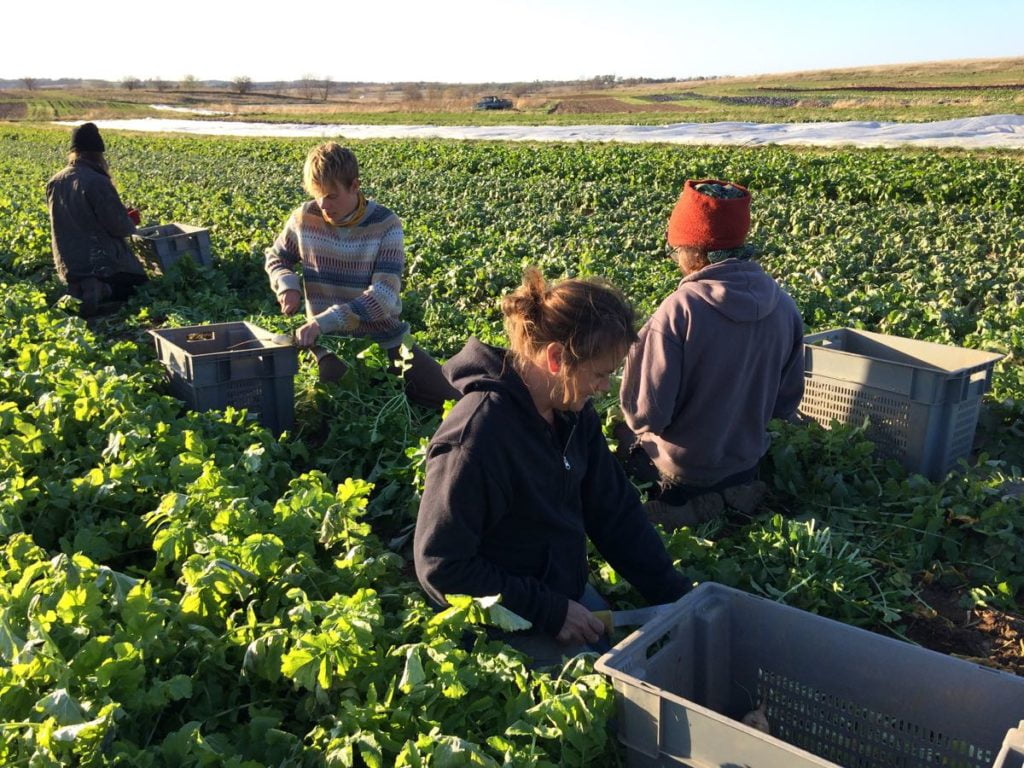
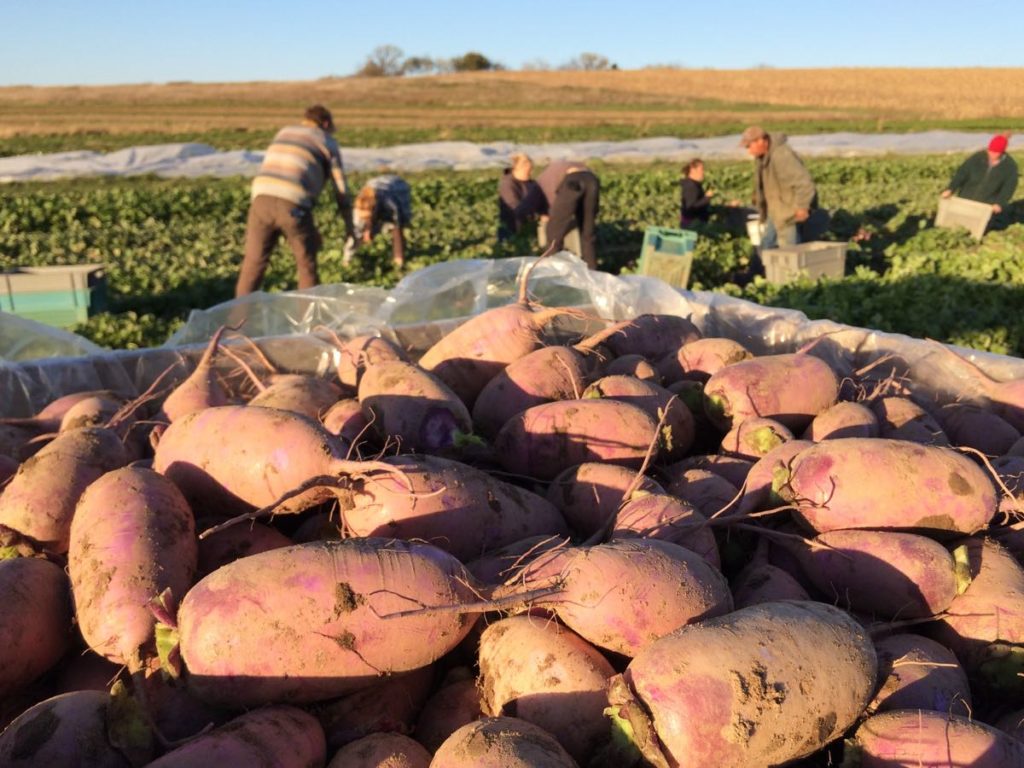
We spent Monday afternoon harvesting white and purple daikon to store for winter sales. The top photo is not adjusted; the leaves really are the brightest shade of green. We always harvest daikon by hand. It’s too fragile for machine harvest.
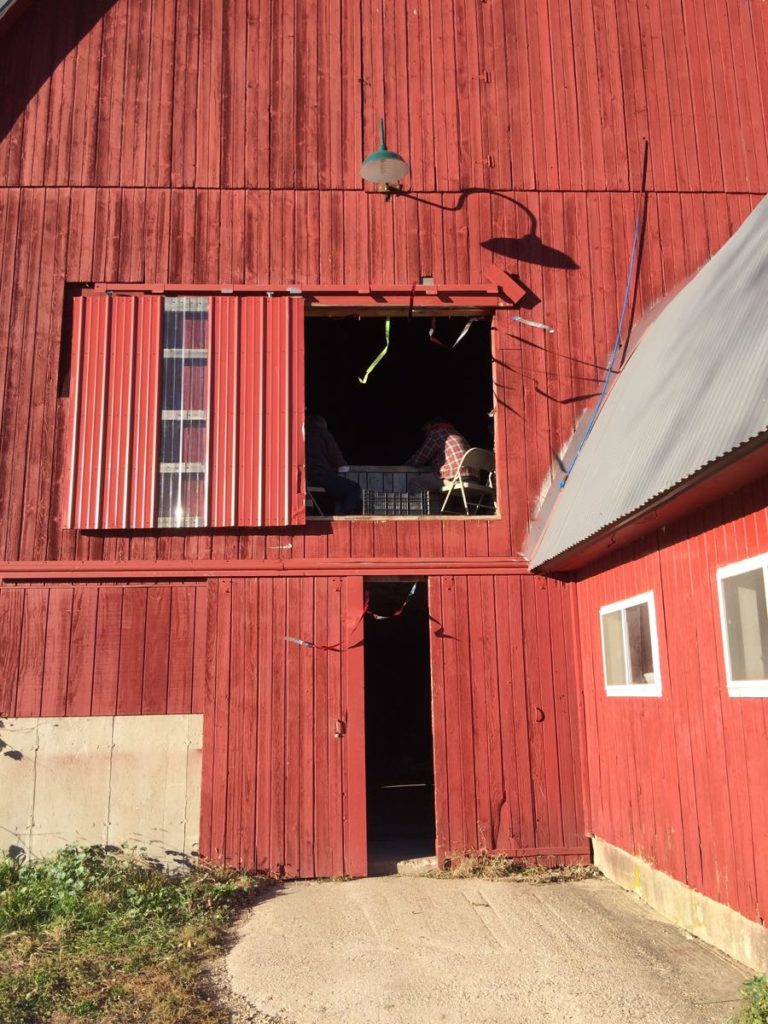

There are a few warm nooks to work. The barn loft is a favorite, sheltered place on a sunny day. Sister and brother Sena and Michio prep onions in the loft. The flying ribbons deter birds when the doors are open.

Our small ginger greenhouse is the warmest place we’ve got. You might need a winter coat outside but it’s t-shirt weather inside when the sun shines. Kristen digs and trims ginger that has grown all summer in this small greenhouse.
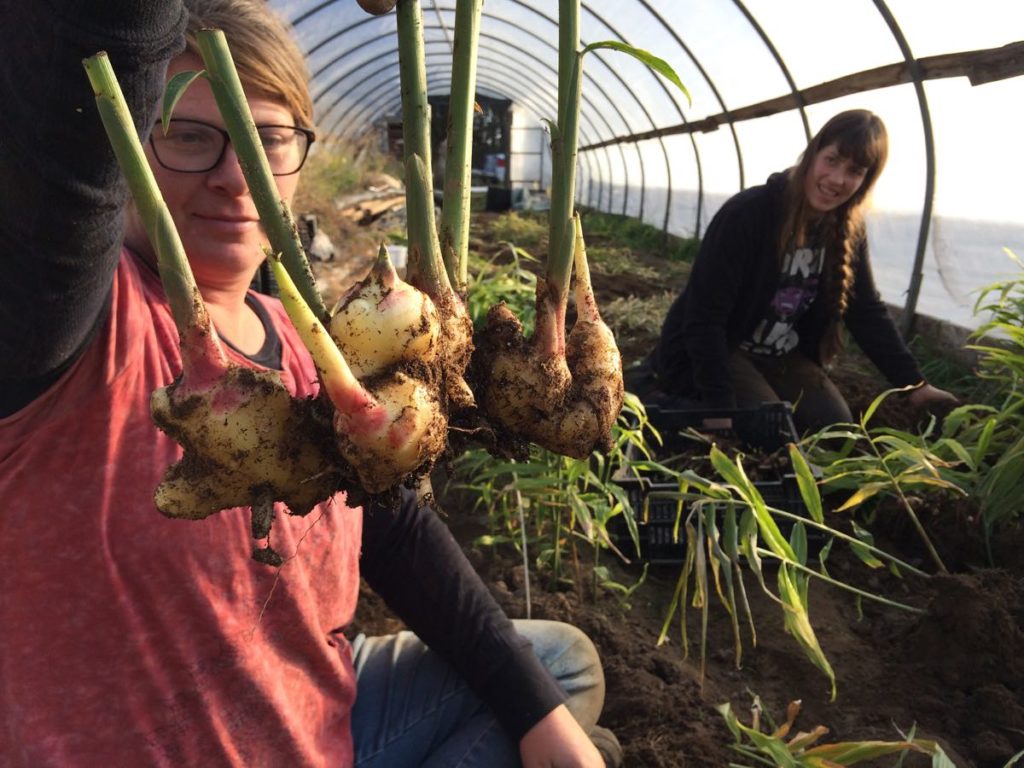
Kristen holds up an unusually robust ginger ‘hand.’ She and Charlotte did the digging.
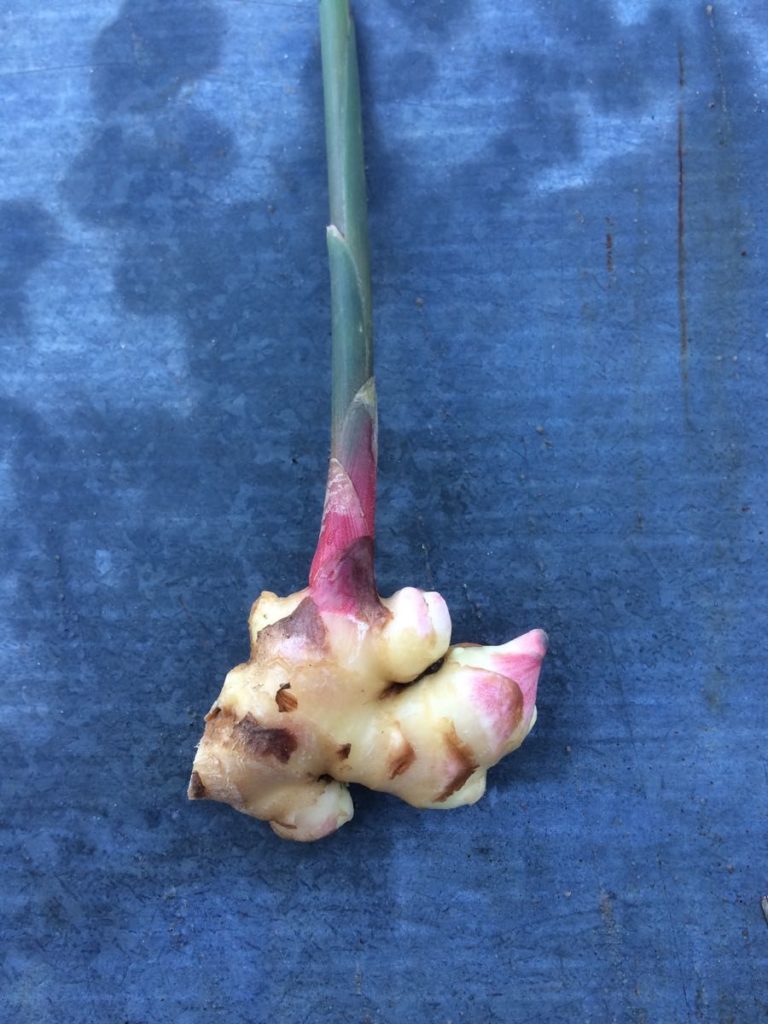
My job was to trim the hands into small pieces to share among the CSA boxes.
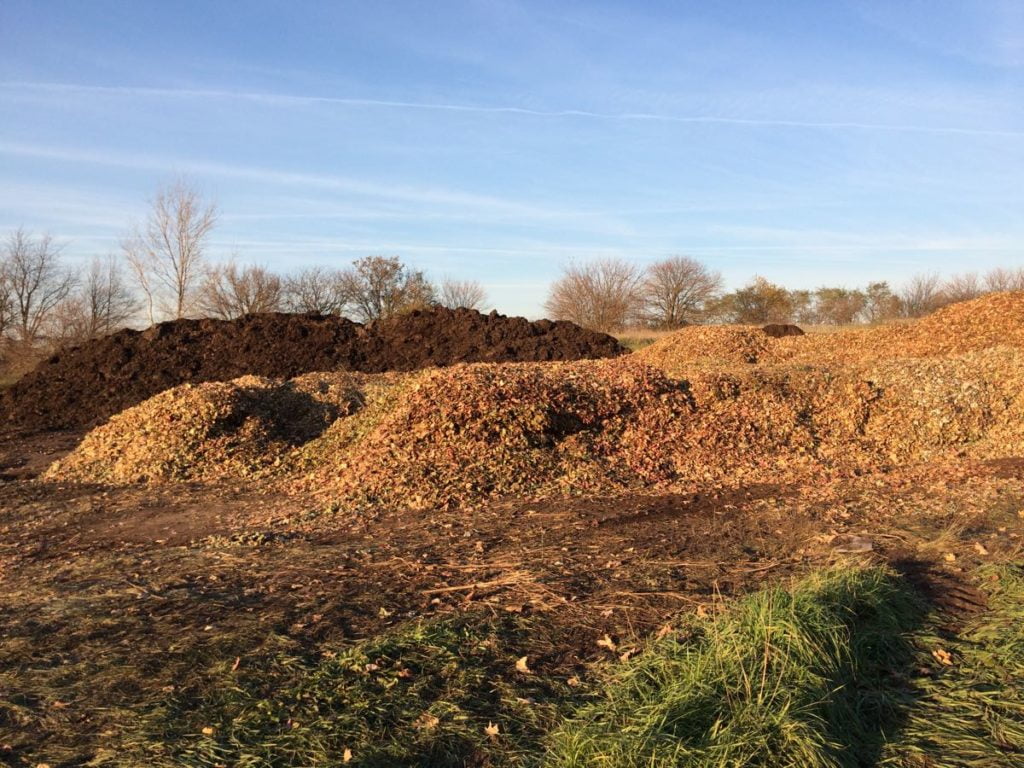
The nearby city of Evansville delivers their leaves to our farm each fall. Delivery began this week, with the fresh leaves in the foreground, and last year’s leaves in the darker pile behind. We let the leaves rot for six to twelve months, then add them to our soil to build organic matter. It’s a wonderful resource. The smell is incredible as the town crew heaps up the leaf piles. It’s a fruity smell similar to curing tobacco. You can smell it all over the farm. It’s a special part of fall for us.

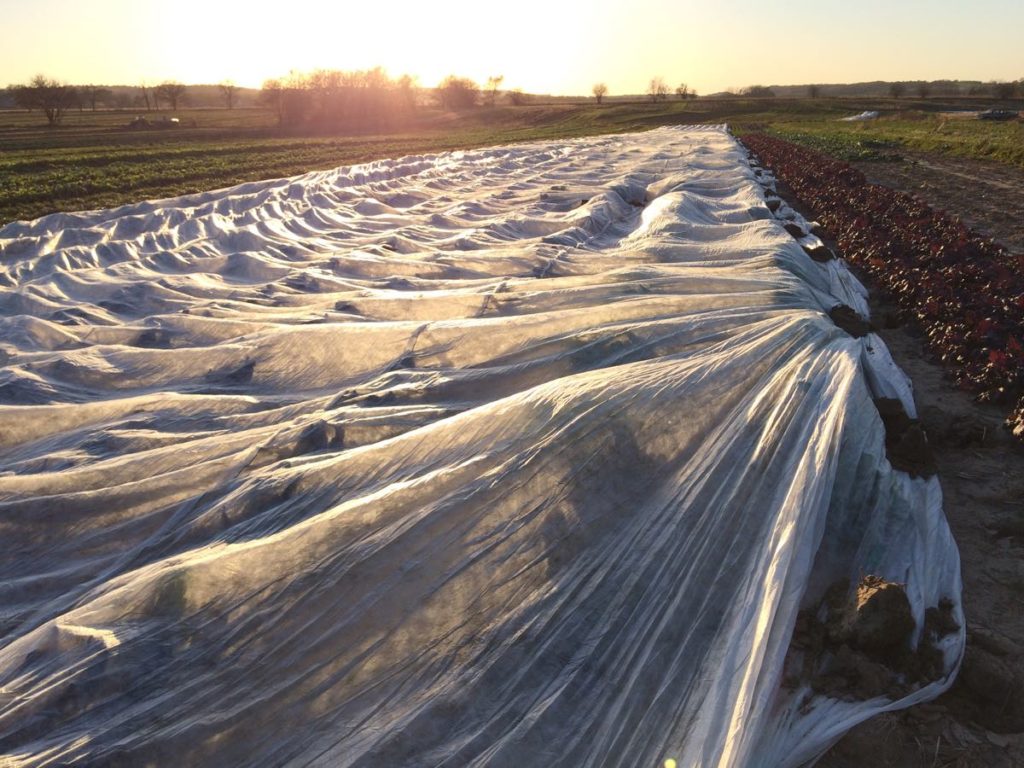
The moon has been brilliant all week. Strong winds on Saturday ripped a large row cover laid over fennel. Steve and I couldn’t get the cover back in place until about 11 pm, after the winds died. By then, we’d been to dinner at friends’ house and drunk a bottle of wine together. Honestly, we were not excited to go back to work at that time of night. But we got out there and the moon was shining and the row cover rippling in the light. It was a lovely moment. The photo above is from daytime but you get the idea. Beth
Veggie List and Veggie Notes
Week #23, October 25/26, 2018
– weekly shares
– green EOW
Green EOW members, this is your final delivery of the regular CSA season.
Thank you for joining our farm this season!
Butternut squash, 1 small
Acorn squash OR a 2nd butternut
Satina potatoes, 3.5 lb
Brussels sprouts, 1/2 lb
Bok choy
Carrots, 2 lb
Bell peppers, green &/or red, 3 – 4
Yellow onions, ~2
Cilantro, 1 bunch
Jalapeno chile, 1
Garlic, 1 small
Fresh baby ginger, 1 knob
By site …
1 small cauliflower or 1 small Romanesco or 1 broccoli
Next week’s box will probably contain sweet potatoes, Brussels sprouts, carrots, parsnips, celeriac, onions, Beauty Heart radish and more.
‘Metro’ butternut – This is my favorite butternut. It is productive and tasty every year. These are small; average size <1.5 lb.
Acorn squash – You’ll receive Jester, Carnival, or Festival acorn or a second Metro butternut.
Satina potatoes – These are from Igl Farms.
Brussels sprouts – If you are a new CSA member, please approach Brussels sprouts with an open mind. Many of us grew up eating awful, overcooked Brussels sprouts. These Brussels sprouts are completely different. It’s only a small amount of sprouts this week. Cook and combine with other ingredients from the box to bulk up the sprouts to make a salad with one of the dressings listed below. Brussels sprouts are great with thinly sliced peppers and onions.
Here is our method to cook Brussels sprouts: Wash the sprouts and trim the cut ends. Cut an X in the stem end of large sprouts. Cut a single slit in small or medium sprouts. This does two things. It helps the Brussels sprouts cook evenly, plus it allows them to soak up any marinade or dressing. Place sprouts in a pot with one inch of water in the bottom and steam until tender, 7 to 10 minutes. If the sprouts are uneven in size, then set aside the smallest ones and add to the pot after the larger ones have cooked for a few minutes. Don’t overcook them! You can also oven-roast Brussels sprouts.
Here are a few dressing ideas for cooked sprouts:
– Sherry vinegar/olive oil/Dijon mustard/garlic/white wine/salt and pepper. This is our favorite, especially when you combine the Brussels sprouts with slivered peppers and thinly sliced onions. Delicious warm, cold, or at room temperature.
– Balsamic vinegar/olive oil/garlic/salt and pepper
– Lemon juice and zest/melted brown butter/poppy seeds/white wine/garlic/salt
Bok choy – We are sending the bok choy with cilantro, jalapeño, garlic and fresh ginger, a perfect combination for soup.
Bell peppers – Eat soon! These will not store for long.
Garlic – These small heads are from our friends Hans and Katie of PrairiErth Farm.
Baby ginger – This is baby ginger, bright white and pink because it hasn’t grown a brown epidermis yet. The ginger in stores grows for a long season in warm places like Hawaii. Baby ginger is special because it has the full ginger flavor and spiciness but almost no fibers. That’s why it’s used to make the pickled ginger served with sushi. I asked the crew to wash it lightly to avoid bruising. Expect to do a final wash before using it.
Storage: Eat soon; baby ginger is perishable. Wrap in a damp cloth or paper towel, and keep in the refrigerator in a plastic bag. You can also freeze your ginger, then grate as much as you need from the frozen knob.
RECIPES
Visit our 2018 Recipe Log or our 2017 Recipe Log or join our Facebook discussion group.
LOCAL THYME/ Comforting Classics
Umami Cod on Braised Bok Choy
Ginger Curried Carrot Soup
The Fluffiest Mashed Potatoes
Braised Brussels Sprouts and Carrots
LOCAL THYME/ Outside the Box Recipes
Ponzu Chicken and Bok Choy Salad
Sheet Pan Chicken and Fall Vegetable Roast
Southwestern Potato Salad with Pickled Onions
Creamy Sausage, Brussels Sprouts, Carrots and Potatoes
LOCAL THYME/ Quick & Easy Meal
Baked Potato Bar
Week #22, October 18/19, 2018
- On: October 17, 2018
 0
0
A few feet in elevation makes all the difference.
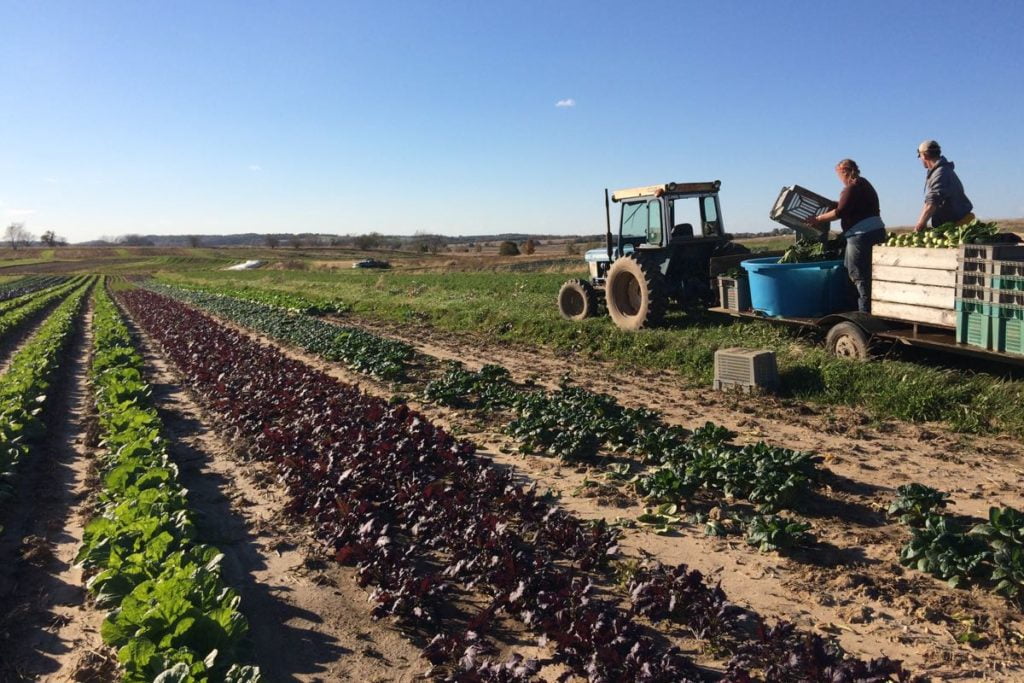
Maggie and Billy harvested your Koji greens on Tuesday.
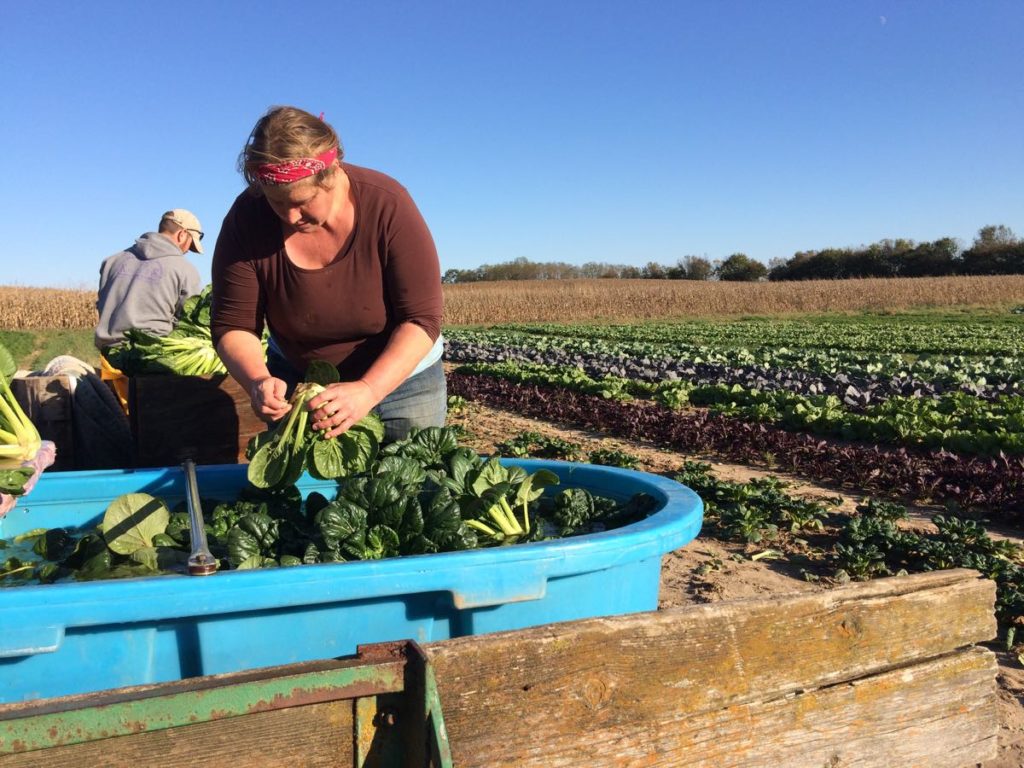
It was warm enough to wash the greens outside. Of course, Maggie is tough and would do this job in much colder weather.

Let’s compare the Koji field (above) with the one we harvested your leeks from last week. See the pickup truck in the distance (to the right of the white row cover protecting fennel)? That’s the bottom of our farm, the lowest point before water drains into the neighboring wildlife area.
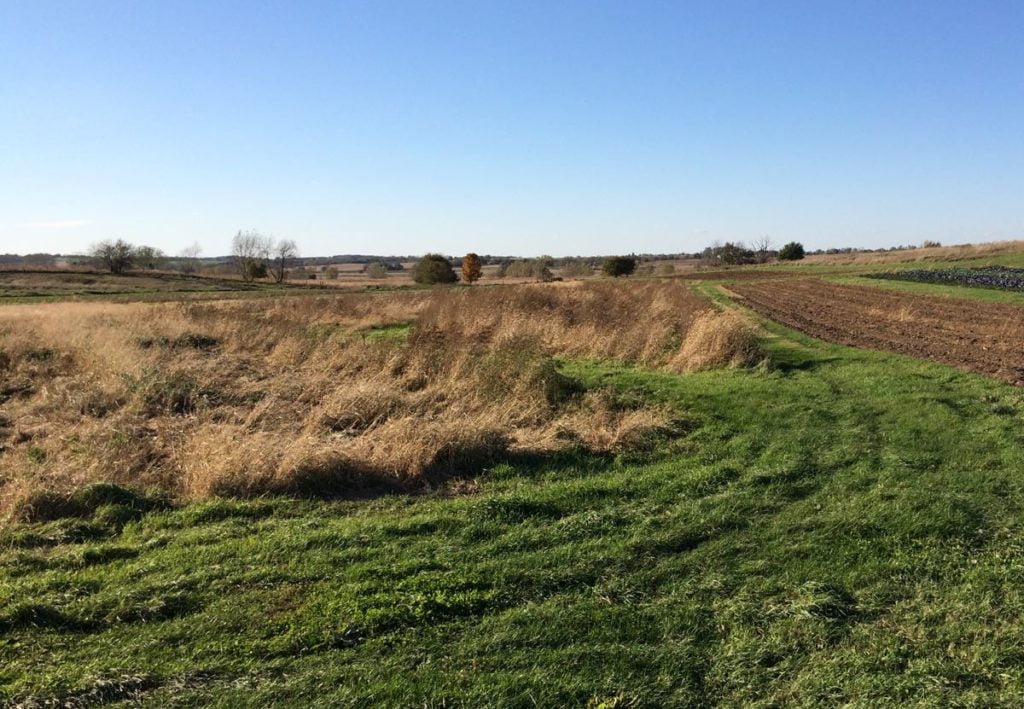
The tall brown grasses are not cover crops. Those are our leek and celeriac fields, buried in weeds. We cultivated several times by tractor but the weeds re-rooted after each rain. Eventually, it was too wet to take a tractor in those fields at all.

The leeks and celeriac are in there; we just have to dig them out. The celeriac did surprisingly well. The leeks are small.
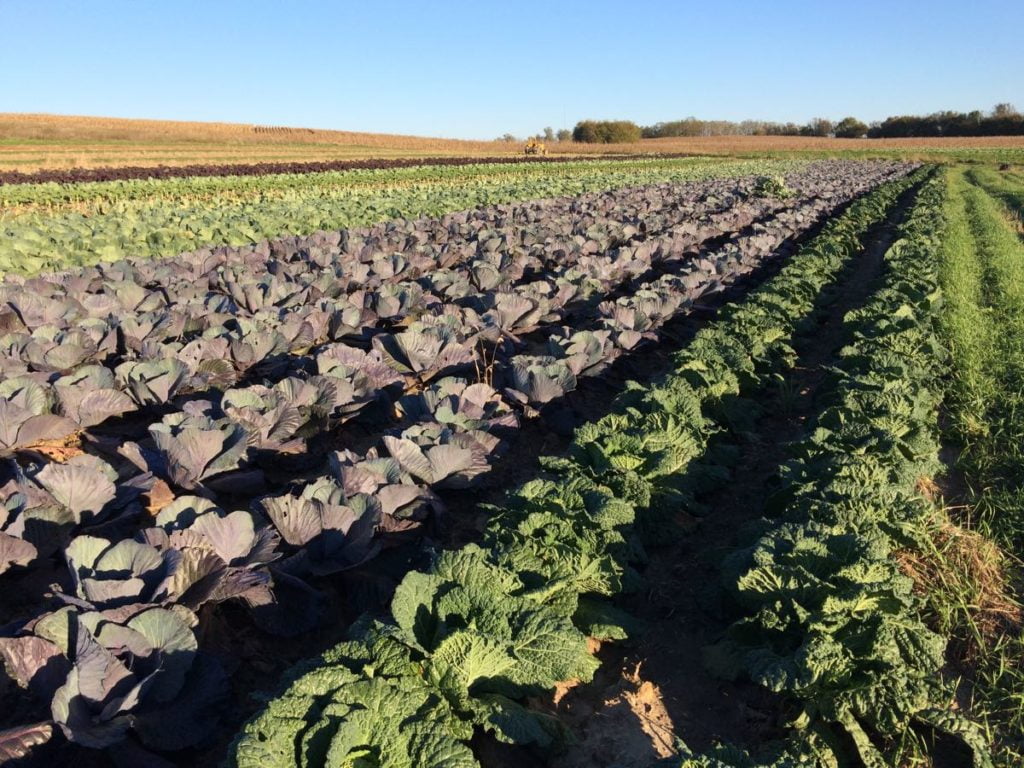
Turn and look up the hill and you find this pristine cabbage field. It’s just a few feet higher in elevation but that was enough for this field to drain and dry more quickly. We were able to successfully cultivate and weed this field and the Koji field shown above. We’re happy to have such nice fall crops. Beth
Veggie List and Veggie Notes
Week #22, Oct 18/19, 2018
– Weekly shares,
– Purple EOW,
– Sun Sampler.
This is the final Sun Sampler delivery.
Red cabbage
Butternut squash
Koji greens
Red beets, 2 lb
Frying peppers, mixed green & red, 6 – 7
Bell peppers, mostly green, ~3
Curly parsley, 1 big bunch
Yellow onion, 1
Red onion, 1
Garlic, 1 bulb
Each site gets one item from this list:
Cauliflower OR purple cauliflower OR Romanesco cauliflower OR broccoli
Next week’s box will probably contain winter squash, Satina potatoes, Brussels sprouts, carrots, celeriac, cauliflower/Romanesco, onions and more.
Red cabbage – This beautiful cabbage is great cooked or raw. We have a favorite winter salad that we make with red cabbage. I’ll include it below.
Butternut squash – This “Nutterbutter” variety is a favorite because it cures and sweetens quickly after harvest. These are golden-orange and delicious.
Storage: Store uncovered at room temperature or a bit cooler. Keep above 55 oF to avoid chilling injury.
Tips for cutting winter squash: Microwave your intact squash on high for one minute before cutting or peeling. That’s enough to warm and soften the squash, making it much easier to cut or peel.
Koji greens – Koji greens are a lot like Yukina if you know that one; dark green with a nice balance of bitter flavor but not too strong. Like tat soi but with larger, lusher leaves and not so many leaf stalks. Recipes that use mustard greens or bok choy will work with Koji.
Beets – Storage: Cover and refrigerate. Beet roots will store for months. Wash well to remove leaf fragments. For all the cooking methods below, wash and scrub the beets but do not peel. The skins slip off easily once the beets are cooked and cooled.
Cooking beet roots on the stovetop: Slice or quarter, cover with water in a pot, and simmer until tender. This will take from 25 to 45 minutes depending on how large the beet pieces are. Drain.
Roasting beets in oven: Wash beets, but do not peel. On a sheet of aluminum foil, put beets (halved or quartered if large), salt, pepper and a few sprinklings of water. Seal the foil packet, and roast at 400 oF until tender, about 45 minutes to 1 hour. Slip off skins once cool.
Microwave: Slice beets in half and place in a large microwave-proof bowl. Add ¾ inch water and cover with a plate. Microwave on high until tender, about 9-20 minutes, depending on your microwave’s power. Drain and slip off skins.
Uses: Use cooked beets in cold salads, or dress simply with vinaigrette, onions, salt and pepper. Beets are also good tossed with sour cream, minced onion, fresh herbs and walnuts.
Frying and bell peppers – These are the last frying peppers but we’ll have a few more bell peppers for you next week. Eat or freeze these soon. Some were picked last week, some were protected from cold under floating row cover. Either approach shortens the storage life. Remember, peppers are easily frozen. Chop raw peppers into bite-sized pieces. Put in a freezer bag or container and freeze. That’s it – there’s no need to blanch them. There’s no need to thaw the entire container at once; you can easily break off and thaw the amount you need. You will enjoy these come winter!
Curly parsley – This is a big bunch. If it’s more than you need, wash and drain well, then chop and freeze in a bag or container. Break off pieces and thaw directly in your dish near the end of cooking.
Garlic – Here’s another German Extra Hardy bulb, with nice fat cloves. We will continue growing this variety!
RECIPES
Visit our 2018 Recipe Log or our 2017 Recipe Log or join our Facebook discussion group.
Beth’s favorite Red Cabbage Slaw
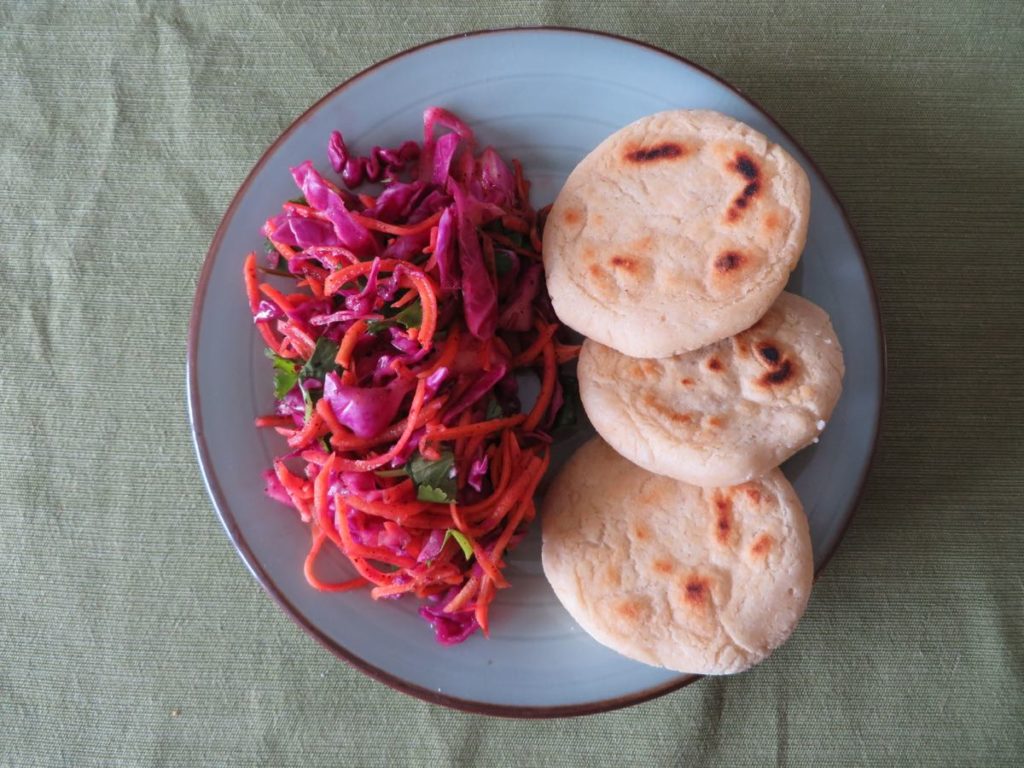
Red cabbage slaw with cheese-filled pupusas. If there’s interest, I can hunt up the pupusa recipe and post in the Facebook discussion group.
Adapted from Taqueria Gila Monster Restaurant’s recipe.
I’ve shared this recipe before but it’s worth sharing again; we seem to survive on this colorful, zesty salad in winter. There are no carrots in this week’s box, but maybe you have a few left over from last week. The slaw holds well, so it’s easy to prepare on Sunday then enjoy throughout the week. Can also be made with green cabbage. Beth
Makes 3 – 4 quarts
.
2-3 lb red cabbage (one small head or half a larger head)
1 lb. carrots
1/2 bunch parsley (good) or cilantro (even better)
1/3 cup freshly squeezed lime juice
1/3 cup apple cider vinegar
1 tsp. salt
1 Tbsp. ancho chili powder
1. Quarter and core the red cabbage. Slice thinly by hand.
2. Peel and grate the carrots.
3. Chop the parsley or cilantro.
4. Toss all ingredients together. Adjust the salt to taste. Let stand 30 minutes before serving. Toss again. Serve as a salad, or as a garnish for tacos or pupusas (pictured above).
LOCAL THYME/ Comforting Classics
Pickled Red Cabbage
Roasted Butternut Squash Puree
Quick Sesame Koji
Beet Salad with Parsley Pesto, Goat Cheese and Pistachios
LOCAL THYME/ Outside the Box Recipes
Black Bean Burrito with Chipotle Butternut Squash and Red Cabbage
Butternut and Ricotta Tart
Pan Seared Chicken Breasts with Curried Peppers and Koji
Beet Chips
LOCAL THYME/ Quick & Easy Meal
Laotian Mung Bean Noodles with Shredded Veggies
RECIPES FROM LAUREN
WARM RED CABBAGE SALAD WITH SQUASH & CHICKEN
Inspired by Epicurious
Takes 1 hour, most of it inactive.
Serves 4 as a meal (8 as a side).
1 tablespoon olive oil
1 teaspoon kosher salt
1/4 teaspoon freshly ground black pepper
1 butternut squash, peeled, halved and cut into 1/4-inch slices
2 pounds beets
1/2 head red cabbage, shredded
1/2 red onion, sliced=
1 grocery store rotisserie chicken (or roast your own chicken if you are feeling really ambitious), shredded (about 5 cups meat)
1 cups walnuts, toasted
4 ounces high quality blue cheese or gorgonzola, crumbled
Maple Balsamic Dressing:
2-3 large garlic cloves, minced
1/4 cup balsamic vinegar
1 tablespoon Dijon mustard
1 tablespoon maple syrup
3/4 cup olive oil
1/2 teaspoon kosher salt
1/4 teaspoon freshly ground black pepper
- Preheat oven to 425 degrees. Toss butternut squash with olive oil, salt and pepper. Roast for 45 minutes tossing once or twice for even browning. Wrap beets in foil and roast alongside the squash for 45 minutes or until they are well-softened (so the peel slips off easily).
- In a large bowl, combine red cabbage and onion.
- In a small bowl, preparing dressing by whisking together garlic, balsamic, mustard and syrup. Add olive oil and whisk until thick and creamy. Add salt and pepper. Taste and adjust seasonings as desired.
- When squash is finishing roasting add to bowl of cabbage along with chicken. Remove beets from foil, slide skins off and then slice thinly. Halve the circles if large. Add to salad.
- Dress as much of the salad as you plan to eat tonight and toss to coat. Sprinkle walnuts and blue cheese over salad and serve warm.
.
GENERAL TSO’S CAULIFLOWER
Adapted (barely) from Pinch of Yum
I can’t take any credit for this totally creative, totally genius way to make everyone’s favorite take-out Asian food at home (and a bit healthier!). I only take credit for sprucing it up with a couple more veggies. This recipe may look complicated with a lot of ingredients and steps but it really comes together pretty effortlessly and the payoff is way worth it. Enjoy! Lauren.
Serves 4 (generously).
Takes 45 minutes.
Rice:
1-3/4 cups water
1 teaspoon Kosher salt
1 cup white rice
General Tso’s Sauce:
1 tablespoon olive oil
1-inch ginger, peeled and minced
3 garlic cloves, minced
1/2 cup chicken (or vegetable) broth
1/2 cup soy sauce (or tamari)
1/3 cup rice vinegar
1/4 cup sugar
2 tablespoons cornstarch, dissolved in 2 tablespoons of cold water
1/2 teaspoon red pepper flakes
2-3 red and/or green Italian fryers, diced (about 2/3 cup)
Fried Cauliflower:
Vegetable oil
1 cup flour
2/3 cup cornmeal
1-1/2 teaspoons baking powder
1 tablespoon Kosher salt
4 eggs
Water as needed (about 1/3 cup)
1 head cauliflower (or purple cauliflower or romanesco cauliflower), cut into bite-size florets
For Serving:
1/2 yellow onion, thinly sliced
1/4 cup finely chopped curly parsley
1 tablespoon sesame seeds
- In a medium sauce pan, bring water for rice to a boil. Add rice and salt. Reduce heat to low, cover and cook for 18 minutes. Uncover and fluff with a fork.
- Heat olive oil in a small sauce pan over medium heat. Add ginger and garlic. Saute for a coupe minutes until fragrant. Add broth, soy sauce, rice vinegar, sugar and cornstarch slurry. Whisk to combine. Bring mixture to a boil, reduce to a simmer, stir in red pepper flakes and cook for 20 minutes until thickened. Stir in diced peppers and set aside.
- Meanwhile, prepare your fried cauliflower. Pour two inches of vegetable oil into a deep, heavy bottomed skillet. Heat over medium heat.
- Prepare your batter by combining flour, cornmeal, baking powder, salt, eggs and water. It should be thick enough to coat the cauliflower but thin enough to easily run off. Adjust this thickness with a little more water if needed. Dump in the cauliflower florets and stir until very well coated.
- Drop a bit of batter into the oil. If it floats to the top, it’s ready. If it sinks, the oil needs to be a little hotter. Once the oil comes up to temperature, fry a quarter of the cauliflower one batch at a time. Cook for 3-4 minutes until golden brown. Drain each batch on fresh paper towels.
- When ready to serve, toss fried cauliflower with General Tso’s sauce. Serve over rice and garnish with some onion, parsley and sesame seeds.
.
Week #21, October 11, 2018
- On: October 10, 2018
 0
0
Farm News
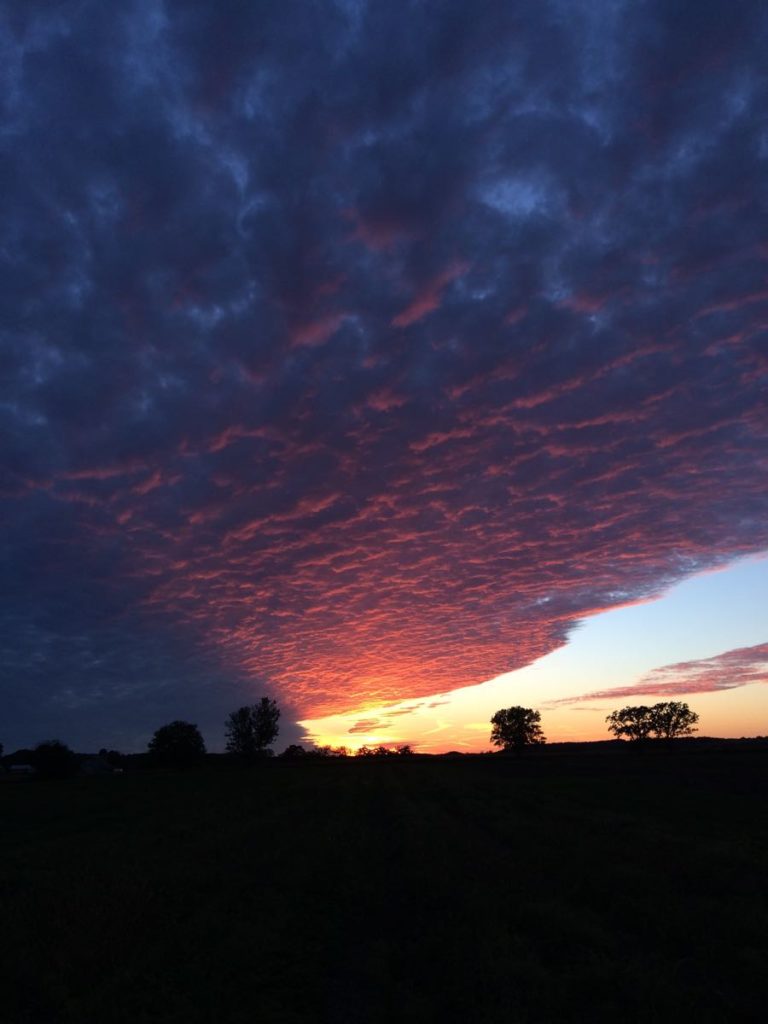
It’s likely to frost this week. Watch the sky as the cold front moves in. Sunsets can be spectacular. I took this photo on September 28, the night before our first, very light frost which barely nipped at the crops.
The upcoming cold weather will do more damage. Hey, it’s mid-October and time for this change. Look at the low temperatures predicted for next few days: 32, 29, (40), 30, 30 oF. We’ve started stripping peppers before they get damaged. You’ll get a bunch of bell peppers this week, many of them green. We plan to protect a few crops with lightweight row cover (fennel, other peppers) but everything else should be able to handle the cold. Cauliflower, Romanesco, root crops, and Brussels sprouts take these temperatures in stride. Tender crops like sweet potatoes and winter squash are tucked away in heated spaces.
Look at the precipitation forecast! There’s almost no rain coming. Steve asked that I tell you we got only 2 inches of rain this week. After this summer, he says “it doesn’t count as a wet week unless we get 4 inches.” For perspective, we’re happy to get 4 inches during a typical summer month.

We harvested your carrots by hand again this week, grubbing them out of muddy ground. Jory and Billy might be exaggerating the difficulty of the job but not the mud.
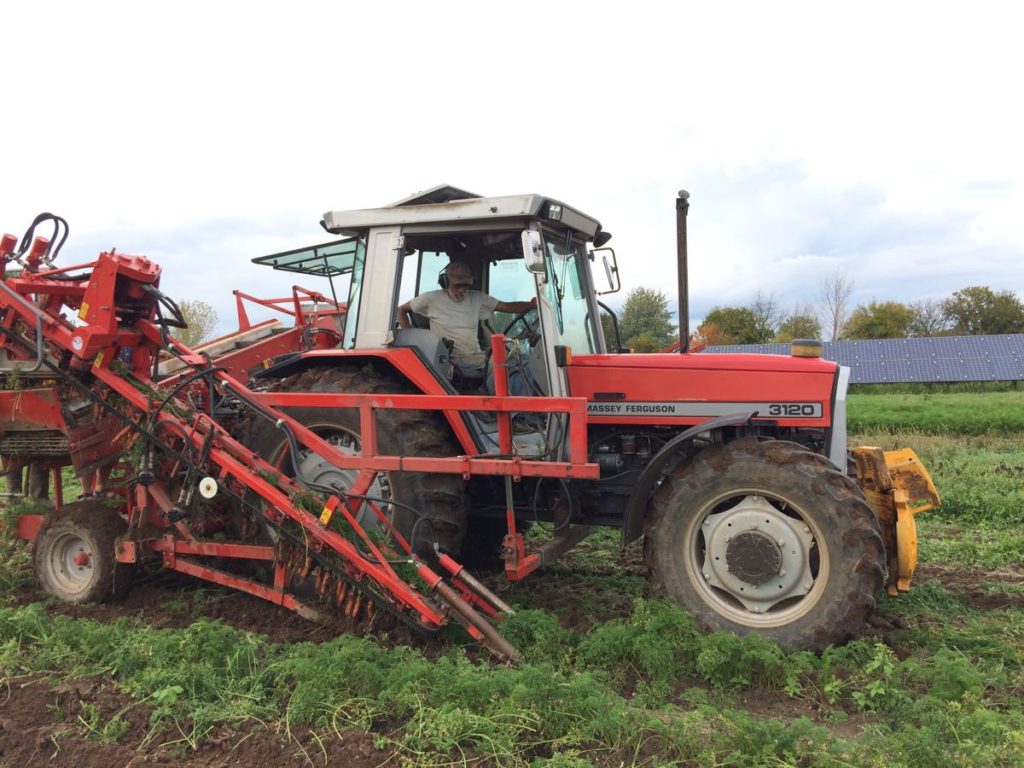
By mid-week, the ground was dry enough for Steve to use our mechanical carrot harvester. He considered trying earlier this week but we talked him out of it. If that tractor gets stuck in the mud, we don’t have anything powerful enough to pull it out. We’d have to call in a tow rig and that’s expensive and embarrassing. Beth
Garlic harvest
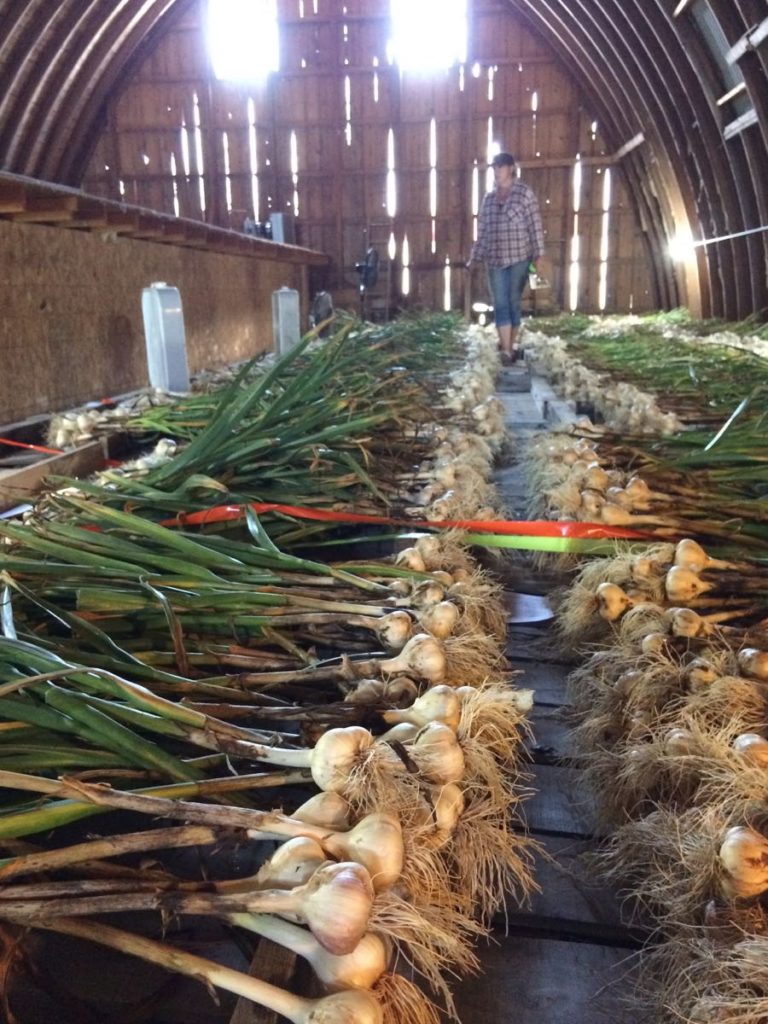
Garlic drying in our barn loft soon after harvest in July. Our barn is a good place for this, dry with good ventilation. We lay the garlic on overturned wooden bins, the same bins we will soon fill with carrots for winter.

This year’s garlic has nice, plump cloves.
Our garlic crop is excellent this year, the best we’ve ever grown. Unfortunately, it was a terrible year for many garlic farmers in the midwest, including our friend John Hendrickson who lost his entire crop. He thinks his garlic was damaged during the warm spell in February. Snow melted, then froze again in sheets. That’s hard on garlic. John usually grows about half our CSA garlic, so this is a big loss. I’ve checked around and (not unexpectedly) there is little good-quality local garlic available for sale.
Fortunately, we scaled up our garlic planting last fall, with plans of packing more in the CSA boxes. We will use that larger harvest to plant an even bigger field this fall, so we can grow all your garlic and not rely on someone else. We were lucky in our field choice last year. We planted in a small, elevated field with good drainage and laid down an unusually thick mulch. I think that’s what saved our crop this winter: good drainage and a thick mulch. We’ll try to replicate those conditions when we plant this year. I’ve held off packing garlic in the CSA boxes while we had good herb options growing outside. We’ll deliver nice bulbs over the coming weeks. Beth
Veggie List and Veggie Notes
Week #21, October 11/12, 2018
– weekly shares
– green EOW
Sweet potatoes, ~2.5 lb
Carrots, 2 lb
Kale, Red Russian or lacinato or green
Celery
Leeks, 2 skinny, ~1/2 lb
Daikon radish, ~1 lb
Bell peppers, 5?, mostly green, maybe 1 fully or partially colored
Oranos snack pepper, 2 or 3
‘Habanada’ not-hot habanero, 2
(in bag with carrots to distinguish from the Oranos)
Yellow onion, 1
Garlic, 1
Each site gets an item from this list:
broccoli OR cauliflower OR Romanesco cauliflower OR purple cauliflower OR globe eggplant
Next week’s box will probably contain butternut squash, beets, peppers, onions, garlic and more.
‘Beauregard’ sweet potatoes – Here are a few things we’ve learned about sweet potatoes:
– For best flavor, cook your sweet potatoes so they brown and caramelize. We have a simple, favorite way to roast sweet potatoes. We used to prepare sweet potato fries in the oven. Now we just quarter the potatoes, rub with olive oil, dust with salt and place cut-side-down on a cookie sheet. Roast in a 450 F oven without turning until soft. The flavors will caramelize (like sweet potato fries) but preparation is simpler and the cooking time less exacting. Slender sweet potato fries go from undercooked to overcooked in the blink of an eye. Larger slices are less exacting, and therefore are easier. Small sweet potatoes can be cut just in half. Jumbos will need to be chopped into pieces. Otherwise, they will take a long time to cook.
– Store your sweet potatoes at room temperature. They suffer chilling injury below 50 F.
– The sweet potatoes we grow require slightly longer cooking than ones from the supermarket, perhaps because they contain higher moisture so soon after harvest.
– Sweet potatoes are good at any size. We have cooked everything from tiny to jumbo and consistently find that all sizes taste good.
Kale – You’ll receive either Red Russian (pink midveins) or lacinato (dark green and bumpy) or green kale (medium green, with wavy leaf edges). All are from fields in good shape. The kale is tender enough to use raw but can be cooked too.
Celery – Our celery is more strongly flavored and more fibrous than typical grocery store celery. Taste it raw then decide how you want to use it, raw or cooked. This is one of our better batches of celery, which we pack in the CSA boxes just once per year. We’ve pushed the planting date later. We want to avoid summer harvests because the celery is tough if it matures during hot weather. Harvest too late in the fall and insect problems accumulate. Who knew celery is so finicky to grow?
Leeks – Well, this is not our best leek crop. You will receive two spindly little leeks this week. They were in a wet field this year and we lost control of the weeds. They’ll be better next year.
Daikon radish (long white root(s)) – This is a Japanese radish, good cooked or raw.
Ideas: (i) We specifically send the daikon with carrots so you can make mixed grated carrot and daikon salad. Dress with a simple marinade of rice vinegar, mirin, soy sauce, sesame oil and a pinch of sugar. Even a brief marination mellows the radish’s sharpness.
(ii) I look forward to making Cubed Radish Kimchi. You can ferment it if you wish but I often just eat it fresh.
Storage: Cover and refrigerate.
Bell peppers – It has been a poor pepper year. We usually send many more peppers in the fall CSA boxes. Unfortunately, most large peppers rotted during the rain. Now that frost looms, we’ve begun stripping the pepper fields, and will have bell and frying peppers for another week or two. You’ll get more green peppers than red, yellow or orange.
To preserve, simply freeze your raw peppers. You can do this with bell or frying peppers of any color. Chop raw peppers into bite-sized pieces. Load into a freezer bag and freeze. No need to blanche.
‘Habanada’ peppers – These are an experiment, so we have only two small ones per CSA box but we want to share them because they are interesting. They are packed in the carrot bag, to avoid confusion with the Oranos peppers. These are habanero chiles with all the heat bred out of them. Lo and behold, habaneros have a wonderful fruity flavor. No one knew because the blazing heat of a traditional habanero sears your taste buds. I suggest you just eat them to enjoy the flavor. These were developed through a collaboration between chefs and plant breeders. Go here if you are interested in the background story.
RECIPES
Visit our 2018 Recipe Log or our 2017 Recipe Log or join our Facebook discussion group.
LOCAL THYME/ Comforting Classics
Creamy Chicken and Wild Rice Soup
Baked Beans
Grilled Maple Glazed Sweet Potato
Grilled Steak with Carrot Daikon Salad
LOCAL THYME/ Outside the Box Recipes
Shrimp or Bean Filé Gumbo
Rice Noodles with Chicken, Carrots and Peppers
Kale and Sweet Potato Salad with Roasted Garlic Dressing
Chinese Chicken Noodle Soup with Star Anise
LOCAL THYME/ Quick & Easy Meal
Kale Carrot Juice
RECIPES FROM LAUREN
ROASTED VEGETABLES WITH WHITE MISO TAHINI SAUCE
Adapted from Smitten Kitchen
Serves 4
Takes 1 hour
1/4 cup olive oil, divided
1-1/2 teaspoons Kosher salt, divided
1/2 teaspoon freshly ground black pepper
2 pounds sweet potatoes, peeled and cut into 1-inch cubes
1 head broccoli OR cauliflower OR romanesco, cut into florets
2 small leeks, cut into thick slices
1 bunch kale, stems removed and torn into bite-size pieces
1-2 cooks favorite cooked grain (wild rice is great here!), optional
White Miso Tahini Sauce
1 garlic clove
1/4 cup rice wine vinegar
2 tablespoons white miso
2 tablespoons tahini
2 tablespoons soy sauce
2 tablespoons olive oil
1 tablespoon honey
- Preheat oven to 400 degrees.
- Toss sweet potatoes with 2 tablespoons olive oil, 1/2 teaspoon Kosher salt and 1/4 teaspoon pepper on a large baking sheet. Place in oven while you cut broccoli (cauliflower or romanesco) and leeks. These will take 5-10 minutes longer than these other veggies.
- Toss broccoli and leeks with additional tablespoon olive oil, 1/2 teaspoon Kosher salt and 1/4 teaspoon pepper on a second large baking sheet. Add to oven and set timer for 30 minutes.
- Add kale to broccoli pan. Drizzle with remaining olive oil and sprinkle with remaining salt and toss gently with broccoli and leeks. Place in oven and roast (along with sweet potatoes) for 20 minutes more.
- Meanwhile, prepare you sauce by combining all ingredients in a blender or food processor and mix until smooth.
- Toss all roasted veggies together and drizzle with sauce immediately before eating. If you want to beef it up, toss veggies with a favorite grain right after they come out of the oven.
.
SESAME NOODLE BOWL WITH PORK MEATBALLS & PICKLED VEGGIES
Inspired by Dishing up the Dirt
Takes 1 hour
Serves 4-6
Pickled Veggies
1/2† cup rice wine vinegar
1/4 cup sugar
1 tablespoon toasted sesame oil
1 teaspoon Kosher salt
3 carrots, cut into matchsticks
1 pound daikon (all the daikon you got), cut into matchsticks
Pork Meatballs
3-4 stalk celery, with leaves, roughly chopped
2 habanada peppers, stems and seeds removed
3 garlic cloves, peeled
1/4 cup fish sauce
1 tablespoon sriracha
2 pounds ground pork
1 tablespoon peanut (or olive) oil
Noodles
1/2 pound Soba noodles
1/4 cup maple syrup
1/4 cup soy sauce (or tamari)
2 tablespoons rice wine vinegar
2 teaspoons toasted sesame oil
1 green pepper, finely chopped
1-inch ginger, peeled and minced
1 clove garlic, minced
1/4 cup peanut (or olive) oil
- In a medium bowl, combine vinegar, sugar, oil and salt for pickled veggies. Whisk until smooth and then stir in carrots and daikon. Let sit and pickle while you work on the rest of your meal.
- Preheat oven to 400 degrees.
- In the bowl of a food processor combine celery, habanada peppers, garlic, fish sauce and sriracha. Process until everything is finely chopped and well-combined. Add pork and process until all the beautiful celery mixture is incorporated into the pork.
- Shape pork mixture into meatballs about the size of a golf ball. My mixture yielded just under 40. The size doesn’t matter too much but go for no more than 45 and no less than 30 to ensure they cook all the way through.
- Drizzle baking sheet with 1 tablespoon oil and place meatballs on it. Bake for 30 minutes. Drain grease halfway through if you like. The meatballs are cooked through at this point. If you want them to have a little more browning (as I usually do), you can absolutely heat some more oil in a skillet and cook the meatballs on high heat for 2-3 minutes, turning as you go until browned on all sides.
- Bring a large pot of salted water to a boil. Add soba noodes and cook according to package directions.
- Meanwhile, combine maple syrup, soy sauce, vinegar, sesame oil, green pepper, ginger, garlic and olive oil in a large bowl. Whisk to combine. Once noodles are cooked (and drained), add to this mixture. Use a tongs to evenly coat.
- Serve a bowl of noodles with meatballs and drained pickled veggies. Add a bit of sriracha if you like a bit more heat.
.







